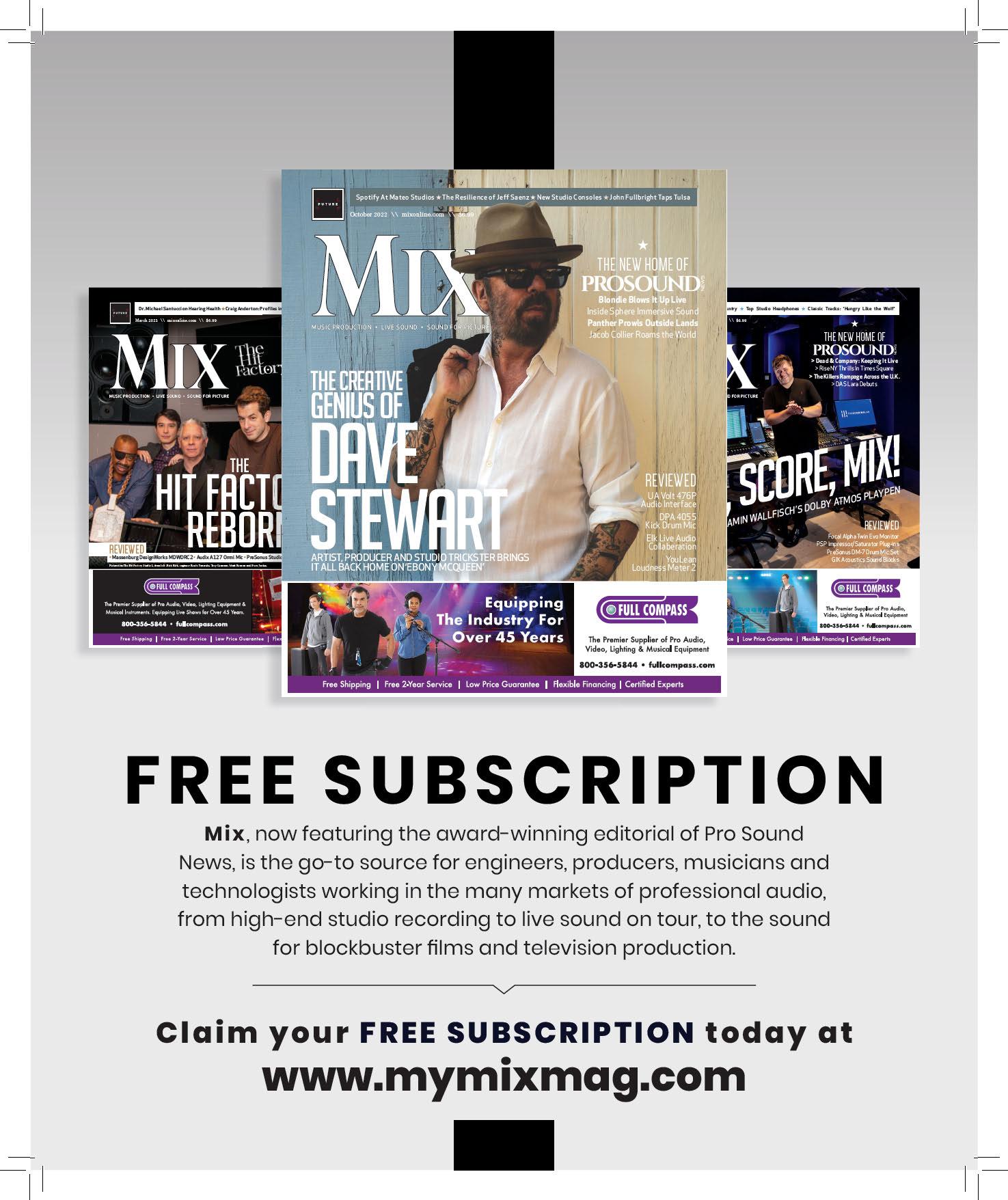


























Volume 48, Number 6


Immersive Updates: Garth Richardson Adds PMC to The Farm; Chuck Ainlay’s New SSL Control; Rob Kinelski Goes Amphion at Home
On the Cover: When 5020 Studio Madrid opened in November 2023, it joined Miami and Mexico City in Sony Music’s expanding 5020 Studio global network of world-class production facilities. This 20,000-squarefoot, three-story complex features two production rooms, two high-end recording studios, audiovisual and photographic content creation, lounges, and event spaces. Acoustic design and system integration by Horacio Malvicino and Febiola Mena of Malvicino Design Group. Photo: Courtesy of Malvicino Design Group.
16 The Simmering Sound of Hell’s Kitchen BY CLIVE YOUNG 18 News & Notes: Meyer Sound at Coachella; Yeager Coliseum Adds a New P.A.; Mitch Rowland on the Road; FOH Engineer Bruce Knight Passes


20 The Class of 2024: Eighteen of This Year’s Top New Studios From the World’s Leading Studio Designers BY THE MIX STAFF

32 The New Knight Center for Music Innovation: U of Miami Looks to the Future of Performance BY JEFF FORLENZA
36 Review: JH Audio Pearl + Ruby BY STEVE LA CERRA
38 Review: Heavyocity Vast Plug-in BY MICHAEL COOPER
40 Review: Harrison 32Cpre+, MR3eq and Comp 500 Series BY MIKE LEVINE
8 Guest Editorial: Sleepless In…
10 Current: View From the Top—Tarik Solangi, RCF USA; NAB Best of Show Awards
42 Open Channel: The Subjective, Objective Perspective BY CRAIG ANDERTON
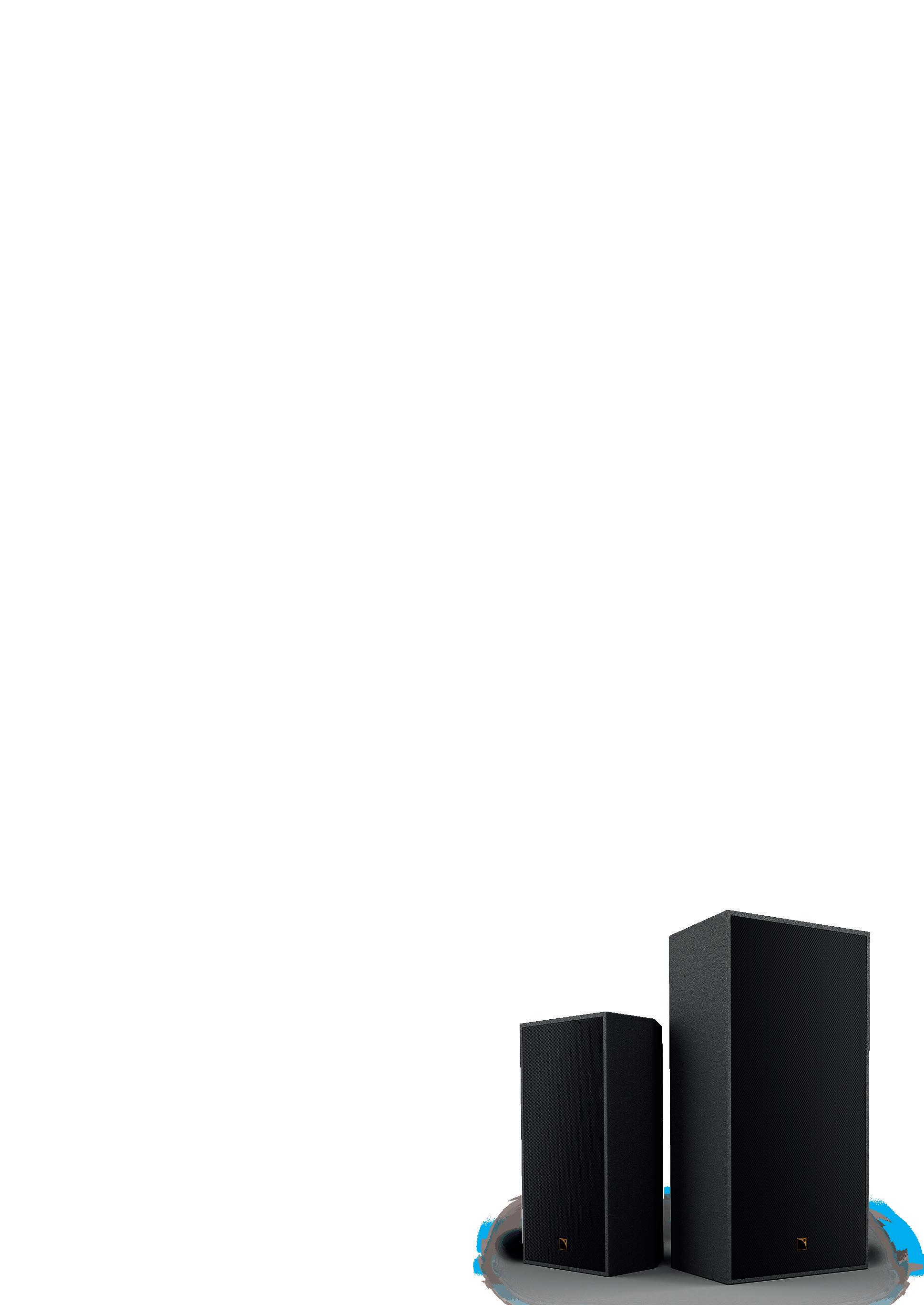


*
*
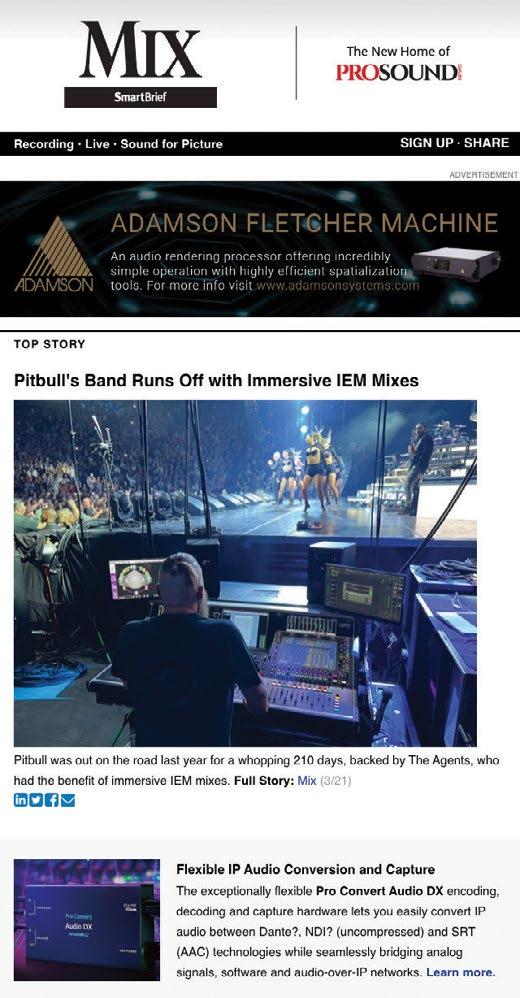
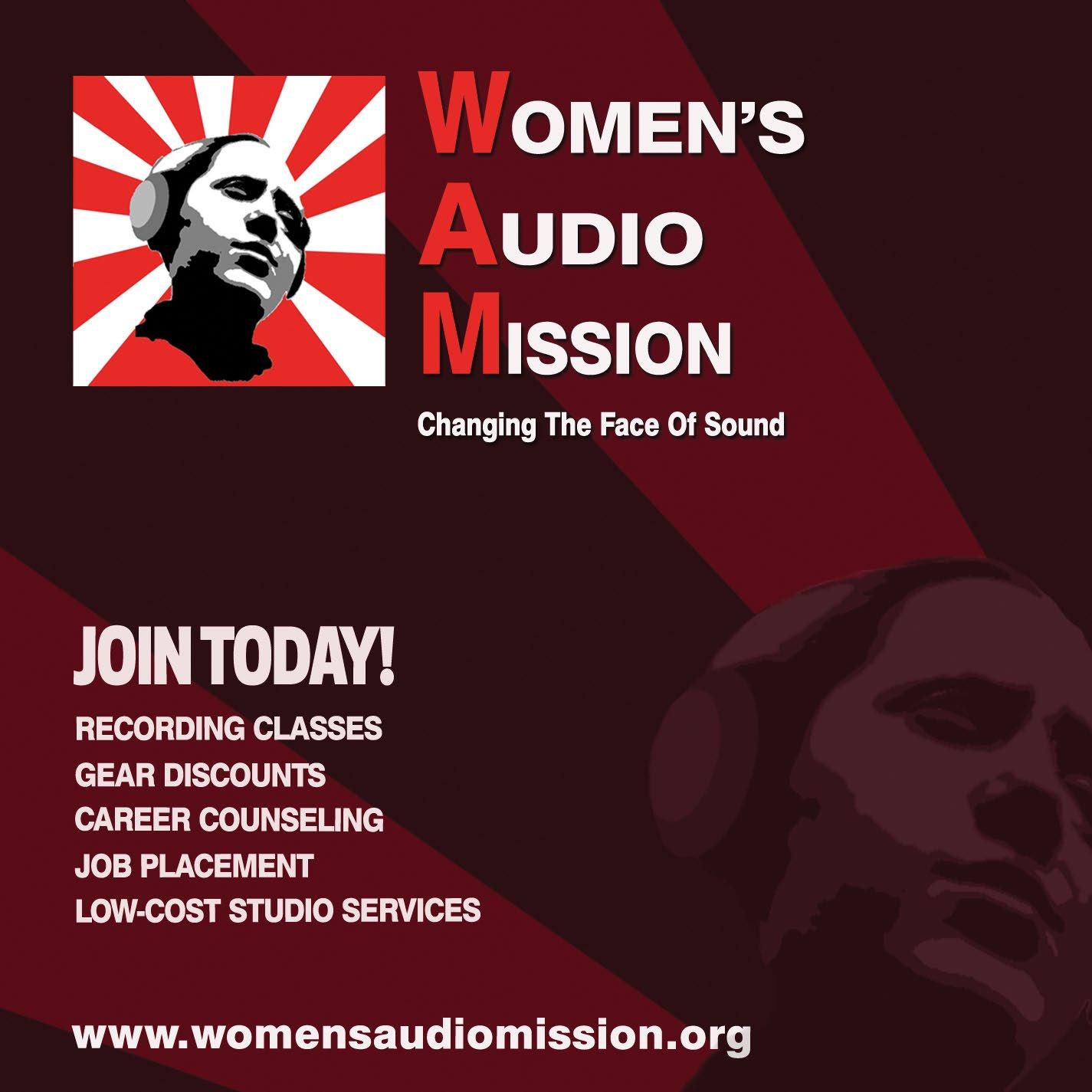
FOLLOW US twitter.com/Mix_Magazine facebook/MixMagazine instagram/mixonlineig
CONTENT
Content Directors Tom Kenny, thomas.kenny@futurenet.com
Clive Young, clive.young@futurenet.com
Senior Content Producer Steve Harvey, sharvey.prosound@gmail.com
Technology Editor, Studio Mike Levine, techeditormike@gmail.com
Technology Editor, Live Steve La Cerra, stevelacerra@verizon.net
Contributors: Craig Anderton, Barbara Schultz, Barry Rudolph, Robyn Flans, Rob Tavaglione, Jennifer Walden, Tamara Starr
Production Manager Nicole Schilling
Design Directors Will Shum and Lisa McIntosh
ADVERTISING SALES
Managing Vice President of Sales, B2B Tech Adam Goldstein, adam.goldstein@futurenet.com, 212-378-0465
Janis Crowley, janis.crowley@futurenet.com
Debbie Rosenthal, debbie.rosenthal@futurenet.com
Zahra Majma, zahra.majma@futurenet.com
SUBSCRIBER CUSTOMER SERVICE
To subscribe, change your address, or check on your current account status, go to mixonline.com and click on About Us, email futureplc@computerfulfillment.com, call 888-266-5828, or write P.O. Box 8518, Lowell, MA 01853.
LICENSING/REPRINTS/PERMISSIONS
Mix is available for licensing.
Contact the Licensing team to discuss partnership opportunities. Head of Print Licensing: Rachel Shaw, licensing@futurenet.com
MANAGEMENT
SVP, MD, B2B Amanda Darman-Allen VP, Global Head of Content, B2B Carmel King MD, Content, AV Anthony Savona
VP, Global Head of Sales, B2B John Sellazzo
Managing VP of Sales, B2B Tech Adam Goldstein VP, Global Head of Strategy & Ops, B2B Allison Markert, VP, Product & Marketing, B2B Scott Lowe
Head of Production US & UK Mark Constance Head of Design, B2B Nicole Cobban FUTURE US, INC.



I’m not a gambler, but I’m willing to bet that anyone working in the concert or recording industries has at least once (if not more often) faced a situation where some kind of project absolutely had to be completed in time for an unrealistic deadline, resulting in an “overnighter.”
Whether it be mixing a record, making a load-in at some ridiculous hour of the morning, or taking brutally early flights to simply get to a gig in another difficult-to-reach city, we’ve all been put in situations where the work hours are crazy and sleep simply has to wait. I certainly recall doing my share of all of the above, mostly in my distant past but admittedly as recently as last year, too. I tell myself, “I’ll catch up on sleep when I get home,” or some similar fable that helps get me through a rough patch.
The brutal truth is that there’s no such thing as catching up on sleep, and in April, the findings of a study were released correlating work schedules deviating from “standard” daytime work hours and poor health decades later in life. The report, “How Our Longitudinal Employment Patterns Might Shape Our Health As We Approach Middle Adulthood,” was undertaken by Dr. Wen-Jui Han, professor at the Silver School of Social Work at New York University, and was published by the online journal PLOS ONE.
“volatility”—i.e., significant variation and variability of work schedule— were more likely to have fewer hours of sleep per day, poorer sleep quality, reduced physical and mental functions, and a higher likelihood of reporting poor health and symptoms of depression at age 50 than people who maintained stable, “normal” work schedules in their twenties and thirties. Yikes.
The concept is not exactly new. Shift Work Sleep Disorder (SWSD) has long been identified by the medical and scientific communities as a disorder that affects shift workers, the symptoms of which are insomnia or acute sleepiness while on the job. According to Han’s data, approximately one-third of the global workforce has a work schedule that qualifies as volatile.
Veteran FOH engineer/audio educator/Mixonline. com columnist Steve La Cerra has discovered a new sleep study that might give audio pros nightmares….
Han collected data from more than 7,300 Americans across the country between the ages of 14 and 22 who were part of the National Longitudinal Survey of Youth 1979. Participants were interviewed every year until 1994, and after that every two years, with a response rate of 96% during the early survey years, and approximately 77% in more recent years. The report’s definition of a “standard” work schedule was described as starting 6:00 AM or later and ending by 6:00 PM. Evening work schedules were defined as beginning at 2:00 PM or later and lasting until midnight, and night-time schedules started at 9:00 PM and ended by8:00 AM.
The findings of the study are simultaneously horrifying yet unsurprising to anyone working in a gig-based industry. The nuts-and-bolts conclusion of the study is that people with work patterns involving any degree of
The average worker in the concert or recording industry almost never works normal hours, and, although they may have a consistent “shift” over the course of a tour, is probably working more like 8:00 AM to 11:00 PM, or later. If you have trouble sleeping in the bunk of a moving bus or while wedged into the seat of an airliner, you’re in serious trouble. Couple this with the lack of many of the “luxuries” provided by normal jobs (health insurance, sick pay, paid vacation, etc.)—all things that allow workers to take a deserved break—and you have a recipe for bad health later in life.
As I get older, I am unfortunately observing the toll this is taking upon my colleagues: back trouble from lifting too many Marshall stacks when they were in their “indestructible twenties,” poor sleep habits that can be traced back to far too many overnighters, depression, and sadly, an increasing number of friends and acquaintances suffering heart attack or stroke.
Those of us who are past the age of 50 can’t go back and change what we did in our early years, but we can get the message out to the younger generation that what they’re doing now will affect their health in the future. It’s going to be a hard sell because many young guns think (as we did), “Ah, what does this old guy/gal know anyway? I’m fine on two hours of sleep.” I’ll certainly be having a conversation with my students about this in an effort to help them understand the value of taking care of themselves in their early work years. I don’t want the quip “I’ll sleep when I’m dead” turning into a truth. n

Reggio Emilia, Italy-based RCF SPA is marking its 75th year in 2024, and to celebrate, the loudspeaker company has been highlighting its well-earned reputation as a mainstay in pro audio throughout Europe and increasingly the world. Case in point: Its North American arm, RCF USA, will be at InfoComm in Las Vegas this month, introducing thousands of pros to a new flagship brand, TT Audio, and spearheading that effort will be vice president of sales and marketing Tarik Solangi.
A veteran of RCF USA for more than a decade, Solangi knows both its brands and the U.S. marketplace well, having built his own reputation not only on sales but also a bedrock of experience in the live sound and recording industries.
“At 24, I realized my dream of becoming a rock star was not going to happen, as I was not that great of a bass player,” he says. “I was, however, good at mixing live sound and recording, so I was able to get the funding to open a rehearsal and recording studio. I started a small production and rental company a year later and did sound for local bands and mixes in many of the New York City clubs.
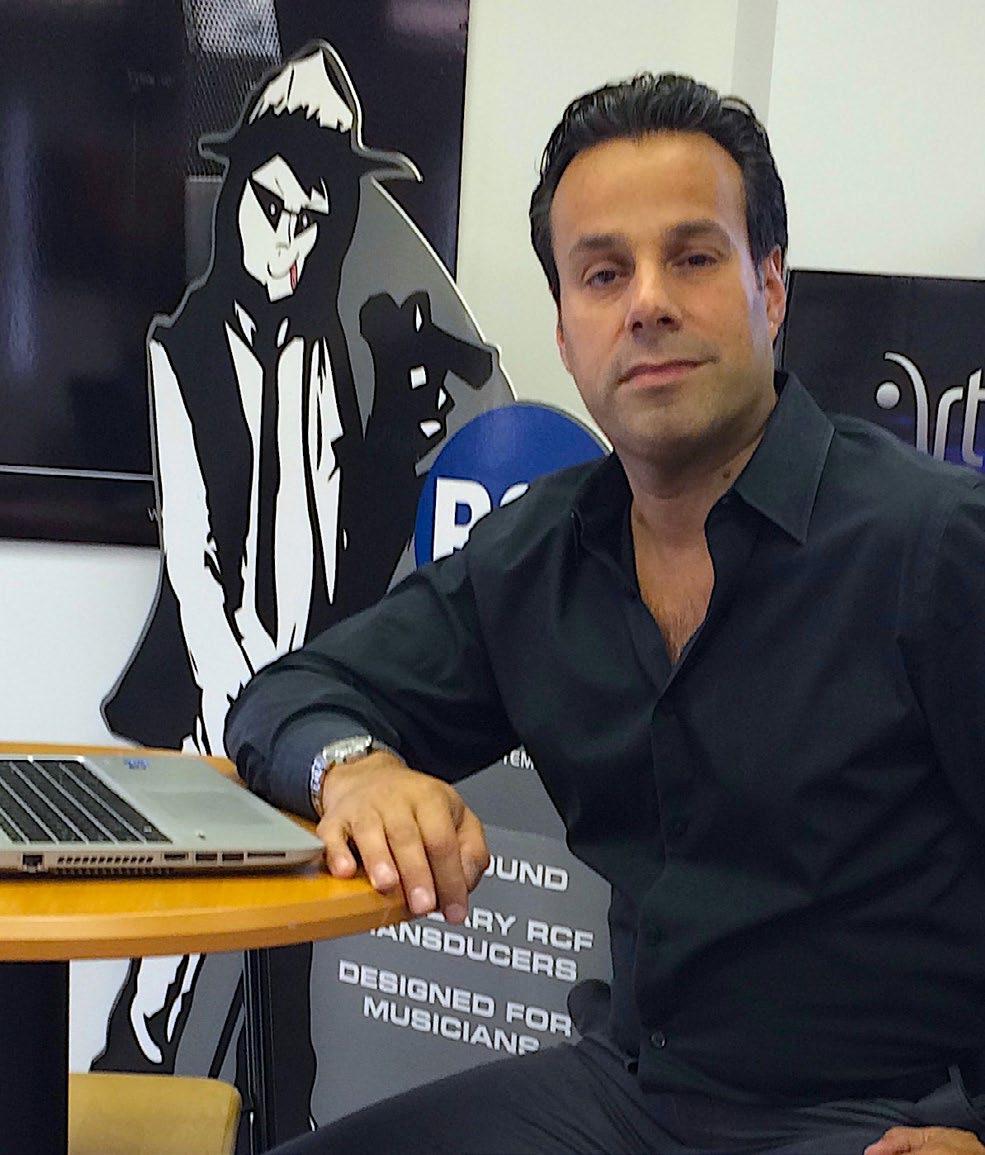
in mid-size portable line array systems—which are being used in live sound production and installations. The RCF line is quite broad; we have products that are successful in retail all the way up to touring, with TT Audio at the top.”
have their specific roles, to be sure. Solangi characterizes RCF SPA as “an engineering-driven company with a strong customer focus,” adding that “90 percent of our manufacturing takes place in our factory in Italy. All product development comes from Italy, with realworld input from our office in the U.S., as well as the other teams from around the world.”
Meanwhile, he says, RCF USA is “a sales company, where everything here is about customer service.” With that in mind, he tends to be very hands-on with all stakeholders, staying connected and ensuring everyone has what they need to succeed. “I don’t like long emails and I don’t send out many,” he admits. “I use the phone, and we can solve an issue in a quick conversation rather than a long, confusing email. I also try to spend half of the month on the road interacting with customers and reps directly.”
“In 2013, I started working for RCF as a product specialist, and after a year in that parttime position, Roni Nevo, the president of RCF, asked me to come on full time in sales. Six months later, Roni promoted me to U.S. national sales manager, and the following year to VP of sales and marketing.”
Coming onboard with RCF when he did allowed Solangi to become a crucial part of the loudspeaker manufacturer’s expanding presence in North America. “RCF has had tremendous growth in the U.S. and around the world over the last 10 years,” he reports. “We found a solid market selling our HDL line—now the leader
While RCF SPA had various U.S. presences in decades past, RCF USA was founded more than 15 years ago, and is directly owned by the Italian parent company. No mere overseas outpost, RCF USA recently moved into a brand-new, 30,000-square-foot facility in Piscataway, N.J., that serves as the headquarters for all North American sales, service and warehousing. As the business has grown, so has its staffing and infrastructure. “We use independent reps to drive our sales; we are very happy with this structure, and many of our reps have been with RCF USA since it started over 15 years ago,” Solangi reports.
The parent company and its U.S. subsidiary
A key to the success of both RCF USA and its parent company has been the ability to provide market-driven products that answer the needs of mid-sized productions and regional/local production and installation companies, as well as the house of worship and club markets. “That is not to say we are not involved in large shows and installations,” he notes. “We have done many stadium and arena projects in the U.S. and around the world.”
Some of those efforts will no doubt be topics of conversation at RCF’s InfoComm booth this month, where those new TT Audio technologies and products will be on display. “We’ve had TT Audio GTX line array systems in use for top-tier performers in top venues across the USA for many months now, and the reviews have been great. Starting with InfoComm, we’re ready to start sharing the TT Audio story with the world.” n
Las Vegas, Nev.—Mix is pleased to announce the recipients of the 2024 Best of Show Awards for the NAB Show, held recently in Las Vegas. The Best of Show Awards recognize innovation and excellence in new, recently introduced and pending products and services for professional TV/video, radio/audio and AV products and solutions. Winners were selected by a panel of professional users and magazine and site editors.
The winning products are:
Adobe Premiere Pro Enhance Speech
Clear-Com Gen-IC Cloud Managed Virtual Intercom Service
Sennheiser MKH 8030
Shure SLX-D Digital Wireless Family Sound Devices A20-SuperNexus
Voyage Audio Spatial Mic Dante
Chessington, UK—Audiotonix, which owns the Allen & Heath, Calrec, DiGiCo, DiGiGrid, Fourier Audio, Harrison, KLANG:technologies, Slate Digital, Solid State Logic, sonible and Sound Devices brands, is shuffling investors. The proaudio conglomerate announced it will receive a next-stage investment from private equity firm PAI Partners; current investor Ardian will maintain a minority stake in Audiotonix via re-investment as part of the transaction.
“I would like to thank Ardian for the confidence and their solid support of Audiotonix, and all our brands since their investment in March 2020,” said James Gordon, Audiotonix CEO, in a statement. “Ardian invested alongside us just as the global Covid lockdowns began, and from our first meeting, they were aligned in making sure all our brands emerged in a stronger position than before, but with the same teams and brand values fully supported. They allowed us to continue our large investment into R&D and supported our desire to add the right brands to our portfolio.”
Gordon noted that teaming with PAI comes after a 12-month effort to find the next partner. n













Tom Petty came alive as I was seated right in the center of engineer Ryan Ulyate’s Dolby Atmos universe, listening to his immersive mix of “Free Fallin’.” Fortuitously, Ulyate lives close by, so I was able to hear Petty’s highest- and longest-charting single at the highest quality and fidelity. It was my first experience listening to Atmos in a real studio, and it moved me to tears. The presence of sound was overwhelming, and, of course, all of that was compounded by the iconic song’s relevance to this Valley girl. When Ulyate observed the emotion, he said it was because this was how music is intended to be heard.
Ulyate believes that Petty would have loved
creating music with Dolby Atmos in mind. Alas the first Atmos Music release was not until REM’s Automatic for the People in 2017, the year Petty died. But, Ulyate says, Petty was always into musical progress if it served the sound.
When they worked together on Runnin’ Down a Dream, for example, the 2007 Peter Bogdanovich documentary on the artist, it was in 5.1 surround, and at the final mix, he and Petty said to each other, “It would be great if we could do that kind of thing [on records].” They then did just that with The Live Anthology, released in 2009, and the following year, Mojo was among the first albums to be released in 5.1 Blu-ray.
Ulyate initially hooked up with Petty via Jeff
Lynne, whom he had met and begun working with around 1997. Through Lynne, he worked on George Harrison’s last album, Brainwashed, and subsequently Harrison’s memorial concert soundtrack, Concert for George. During the mix, Petty stopped in to listen to and approve of his performance with the Heartbreakers.
Shortly after, Lynne called and said Petty wanted to cut a song, could Ulyate make it? “I said, ‘Yeah, well, I think I can,’” he teased. They began working on music that became Highway Companion, released in 2006, followed by the Bogdanovich documentary, where Ulyate was tasked with going through the Petty music archives.
When Warner Bros. called Ulyate in 2020 to
tell him Amazon wanted an Atmos version of Wildflowers & All the Rest and he was welcome to use Dolby’s studio, Ulyate said that if he could get an advance, he would simply refit his studio for Atmos and mix the album there. Warner agreed.
Today, Ulyate runs Pro Tools HDX on a Mac Pro and says about 90 percent of the plug-ins he uses are Massenburg DesignWorks EQ and UA 1176 emulations. For Atmos work, a Mac Studio hosts the latest version of Pro Tools with the Dolby Atmos Renderer, Avid MTRX Studio handles I/O, and it all runs on a Dante backbone.
The “lower” seven monitors (LCR, plus sides and rears) are all ATC SCM50. The four height speakers are ATC SCM12i. Bass management is handled by a Bag End Infrasub-18 Pro, with two more for the LFE channel. “Bryan Pennington from Dolby tuned the room and did an excellent job,” Ulyate says, adding that Zach Winterfeld at TransAudio Group was helpful in setting up the ATCs.
In 2022, following up on Wildflowers & All the Rest, Ulyate undertook the Atmos mix of Petty’s Greatest Hits, originally released in 1994 and consisting of 18 tracks. “Free Fallin’,” he notes, turned out to be an interesting song to mix for immersive playback.
“The challenging thing about this track, or any track that people have known and loved for a long, long time, is you have to be really diligent in making sure that you’ve captured the essence of that song,” Ulyate maintains. “When you’re looking at the multitrack and a bunch of unmixed tracks, you’ve really got to go back and make sure that what you’re putting in that mix is what is in that original mix, because a lot of times there are things that aren’t. Sometimes a vocal will start on one track and end up on another track,
“You have to spend more of your time really capturing the original mix before you can move it into Atmos. What makes a good Atmos mix of a classic track is how much diligence you put into recapturing that original mix and making sure that all the elements that are in that mix are in your mix as well.”
To begin an Atmos mix, Ulyate finds the highest-resolution stereo mix of the song that he can and puts that in the timeline above the multitrack. He listens to both to make sure they are the same speed. “If they get out of sync, I have to change the timing of the multitrack to make it match the stereo,” he says. “That’s important to me
because even if it’s off a little bit, it doesn’t feel the same.”
Then he gets a rough mix of the multitrack that is fairly close to the stereo master so that he can go back and forth between them. “At that point, it’s putting up the vocal to make sure they’re the same,” Ulyate explains. “You have to go through every track to make sure every one of those tracks that you’re putting in there is, in fact, in the master— guitars, percussion, everything. Sometimes stuff is mixed really quietly in the master.
“Once all the elements are identified, the effects are examined,” he continues, “Is there reverb on the vocal? Is there a slap on the vocal? ‘Okay, that sounds like a reverb, but it sounds like an EMT 140 with a 100-millisecond pre-delay.’ Or, ‘Ya know what? Maybe it’s more like an EMT 250 because this was 1982 and everyone had EMT 250s.’ Then I play with all my various reverbs until I get it to feel like it feels on the master. Of course, when I’m remixing a track that Jeff Lynne produced, like ‘Free Fallin”,’ it’s a bit easier. He hated reverb! After that, it’s about EQing stuff and getting it to sound pretty much the same, and then fine-tuning the mix.”

along with the delay echoes of the vocals on the words “Free” and “Fallin’.” One of the coolest things, he says, is the way that the big background vocals fill up the heights.
“I print my own stems, and I have a separate machine that I do all my Atmos in, so I will start playing around in that space, knowing all the instruments and relationships are baked into the mix,” Ulyate explains, noting that certain elements lend themselves to being in front and others lend themselves to being around you. “It’s just not going to work if you put the vocal behind you. I still look at it as if I’m facing the music, looking at it on stage—the vocal, the bass, the kick drum, the snare drum, the main guitars are toward the front. The riff of [“Free Fallin’”] is so interesting. There are three guitars. You’ve got Tom playing guitar on the left and Jeff on the right and Mike in the middle.”
With the LCR of “Free Fallin’” in a good place, Ulyate placed the synth pad that plays throughout the song in the rear, to support the music but not draw attention. He placed an eight-string bass that enters in the chorus into the rear height speakers,
“The way they [originally] recorded it was on a separate 24-track, and they flew them in on two tracks on the 24-track master,” Ulyate explains. “They’re only in stereo on the 24-track master, but I went back to the work tape, where they recorded them individually, and grabbed them from there, then synced them up in Pro Tools, so now you hear the 16-tracks of ‘Ventura Blvd.,’ of Tom and Jeff singing the four-part harmony. So, on the four low notes, you get eight voices, and on the next note up, you have eight more voices, and the next note up, eight more, and the next note up, eight more, so there are 32 voices on ‘Ventura Blvd.’
“It’s beautiful to listen to how this song is constructed. You realize that you don’t really hear a lot of these sounds as individual things in the stereo mix and you see how they all come together. The thing I love about Atmos is that rather than coming together in the speakers, it comes together in your head.”
Pondering what Petty would think about all this, Ulyate remembers the moment it hit him—while working on the Atmos version of Wildflowers & All the Rest: “When I was mixing ‘It’s Good to Be King,’ I got really choked up and thought, ‘If he were around, he would just have loved this.’” n
Juno Award-winning Canadian music producer and engineer Garth Richardson has installed a PMC 7.1.4 monitoring system at his recording studio, The Farm, near Vancouver, British Columbia. Richardson—affectionately known as Gggarth, due to his stutter—has put his stamp on some of the most iconic albums of all time, from Rage Against the Machine’s debut album to records by Red Hot Chili Peppers, Skunk Anansie, Mötley Crüe, Biffy Clyro and Taylor Swift. Richardson’s introduction to PMC came via a recommendation from another Grammywinning producer, Dave Schiffman. Richardson demoed a pair of the speakers, and when he played back the first Rage Against the Machine album, he says, “I could hear everything—all the moves I had done in the studio back in 1991. I liked what I heard so much that I ended up buying a pair of PMC AML2 monitors for myself.

I’ve had them for years and always loved them. They were the main monitors in my control room until we upgraded to Dolby Atmos.”
The Farm features a live room designed by Ron Obvious (who has also built studios for Bryan Adams and Robert “Mutt” Lange), and a control room designed by John Ryan Sullivan of MDRN Acoustic Concepts. Work to upgrade the control room to accommodate a PMC Dolby Atmos monitoring system began in 2022 and was completed at the end of 2023. Richardson’s new 7.1.4 system comprises three PMC6-2 monitors for LCR, four PMC6 monitors for the side channels, four PMC Ci30s for the ceiling/height channels, and four PMC8-2 subs.
“As a producer, I am an innovator who is always evolving and trying to do things better,
which is one reason why I decided to embrace Dolby Atmos,” Richardson says. “I heard an Atmos demo on the PMC booth at NAMM, and I thought, ‘Holy shit, this is brilliant.’ Atmos gives you a 3D canvas and a whole new way of connecting with music.
“I know there are a lot of non-believers,” he adds, “but for me, hearing Atmos at that PMC demo was the first time I felt the music had given me a hug. A good Atmos mix played back in the right setting through great speakers can literally make you cry. Music should make you feel like you are emotionally involved, and that’s what Atmos does. It’s like you are in the room with the band. It’s magical.” n
For nearly his entire career, multiple Grammy, CMA, ACM and TEC Award-winning producer, engineer and mixer Chuck Ainlay sat behind a large console—more often than not a Solid State Logic desk—while tracking and mixing. In 2020, Ainlay started working from home and since then has integrated SSL’s UC1 plug-in controller, multiple UF8 8-channel advanced DAW controllers and the new SSL 360° Link software into his setup.
“I don’t really miss the console anymore,” he says.
Record production has been moving toward hybrid-based workflows for years. But then, observes Ainlay, who has amassed more than 3,500 record production credits during his career, “The industry changed significantly because of the lockdown. Before that time, give me the hardware and I’m going to sit and mix on an analog console, use console automation, the whole deal.”
For many years, he says, he was “the SSL guy” in town. “I’ve just always worked on SSLs. That’s
home, to me.” When SSL introduced its plug-in and DAW controller hardware and the 360° Link software, he was ready to try it out.
Peter Frampton, with whom Ainlay has collaborated for many years, gave him the UC1 plug-in controller. Then, SSL senior vice president Phil Wagner told him, “You should just put one of SSL’s Channel Strip plug-ins on everything. It’ll be just like working on an SSL analog console.”
“Now, when I open a session, I just put Channel Strips on everything,” Ainlay says. “Then I scroll through the channels with the controller. It still feels different than an analog console, but I know exactly what to expect from years of turning the knobs, and you can see on the controller what’s going on without having to look at a screen. It’s as close as you can get to being on an analog console.”

The software, too, offers a similar experience to working on a mixing desk, he continues. “With the new SSL 360° software and SSL 360° Link, visually it’s like you are working on an SSL console, and I have access to all my plug-ins. I feel right at home with the virtual mixing environment that I’ve set up. And now, with 360° Link and my UC1 plug-in controller, I can set up a knob-per-function control of all my favorite third-party plugins.” n
Rob Kinelski, known for his award-winning mixes for Billie Eilish, Karol G and others, has launched a new studio outfitted with an Amphion 7.1.4 monitor setup at his home in the Los Angeles area.
Kinelski’s journey with Amphion speakers began in 2020, not long after mixing Eilish’s debut album, When We All Fall Asleep, Where Do We Go?, for which he won four Grammy Awards. He recalls that he was contacted by Amphion’s marketing manager, Julian Hyvönen, on social media.
“I forget exactly what he said,” Kinelski relates, “but he messaged me on Instagram that he loved what I did on the album and he would love to show me their speakers. They brought a pair of Two18s to my studio to demo, and I said, ‘Well, the only way to know if I like them is to mix a song.’ I sent it out, and that first version
was approved. So, I thought, ‘Okay, this is cool!’” He later added a BaseTwo25 subwoofer to his setup when he moved to a larger space, noting, “The Two18 combined with the BaseTwo25 are loud enough to be my mains, but they also sound good. It’s not like most mains, which are just hyped up. They’re like mastering speakers, with a lot of detail. They’re not forgiving; you hear everything. Lately I’ve been using them on low [volume], because it’s easy to feel it when it’s cranked, but when you’re at low volume, how does the bass sit with everything? Does it feel flubby? That has helped with getting the bass tight.”
Kinelski’s new immersive Amphion rig includes three Two18 speakers across the front, One18s for the surrounds, and One15s for the heights, powered by Amphion’s Amp400.12 multichannel amplifier. A BaseTwo25 bass system provides stereo low-frequency extension

while a FlexBase25 handles LFE information. The room design was a collaboration with studio designer Blake Douglas.
Of the many Dolby Atmos projects that he and his assistant, Eli Heisler, have mixed so far, Kinelski says, “I think the Sabrina Carpenter [Christmas] EP is my favorite. We really were tasteful. I’m finding lately that my favorite way to do it is to be conservative, because when you go too aggressive, in my opinion, it just feels distracting. I don’t want them to be engaged in the Atmos; I want them to be engaged with the song.” n








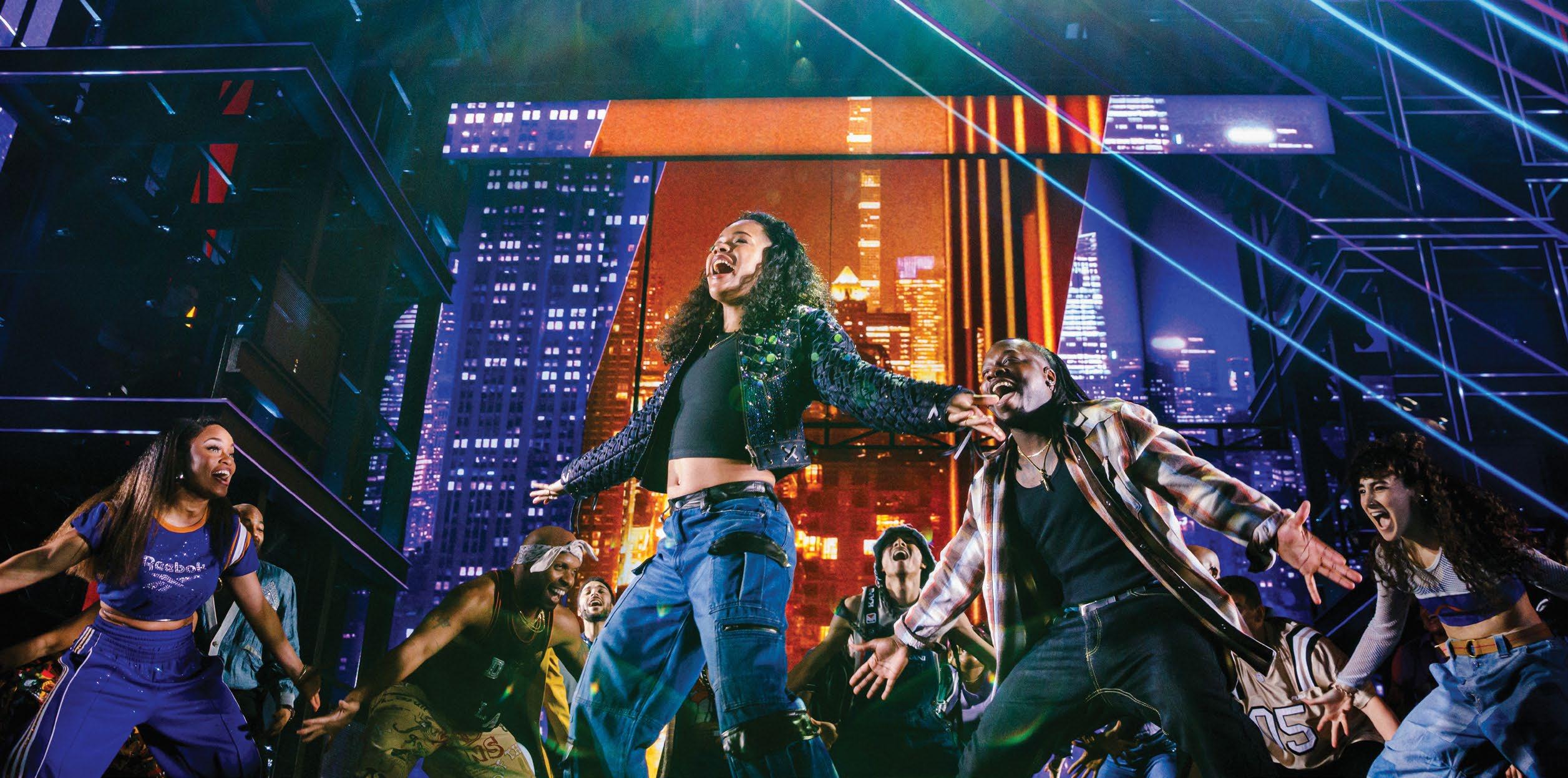
Hell’s Kitchen has all the necessary ingredients for a Broadway hit, and on stage, they mix together for a tasty, crowd-pleasing show. The brainchild of 16-time Grammy Award winner Alicia Keys, the musical takes inspiration from the singer’s years growing up in 1990s New York City, following young high-schooler Ali as she navigates first love, an overprotective mom, a demanding mentor and discovering her true calling as a musician. All throughout, Keys’ familiar hits and a passel of new tunes move the story forward, keeping the audience’s toes tapping along the way. Ensuring that the crowd hears every note is sound designer Gareth Owen, whose work on the show has now been nominated for Best Sound Design of a Musical—one of 13 Tony Award nominations the production earned in April, less than a week after
it opened on the Great White Way.
While Hell’s Kitchen nabbed its nominations practically overnight, its journey to the Shubert Theatre was a considerably longer journey. Keys first began developing the show in 2011, and it finally hit the stage with an Off-Broadway run last fall at The Public Theater. Owen was already onboard with the musical by then, but the audio system he created at the time was a far cry from the one in-use now on Broadway. “We had to use whatever equipment we could get our hands on, and that’s standard for tryouts—you use whatever is available, resources-wise,” he said.
As a result, when the show moved to Broadway, Owen and his team largely started over from scratch, working with longtime theatrical audio provider Sound Associates. “We changed consoles, P.A. systems, amplifiers, processing,”
he recalled. “It’s easier to list the things we didn’t change moving to Broadway.”
Taking the show uptown allowed Owen to switch the house console to an Avid S6L, a desk likewise used on all his other current Broadway productions—MJ (for which he won a Tony), & Juliet, Tommy and Back to the Future. Swapping out desks wasn’t entirely painless; copying and reinterpreting each setting from another brand’s console to the S6L took about a week but proved to be time well-spent as the programming and settings translated tightly.
Based as it is around modern-day pop, the show’s mix uses plenty of plug-ins, he said, noting, “Almost everything that exists in an AAX DSP format, we’ve got running inside the console, but then externally, we have a plug-in host system that’s mostly running reverbs. We’re
running emulations of the t.c. electronic VSS3 and VSS4 HD reverbs, LiquidSonics emulations of the Bricasti M7—the Seventh Heaven plugins—and some plate reverbs; and a whole lot of funky effects from SoundToys.”
Much of the software used at the FOH position, however, is custom written. Owen’s own software house, Show Control Ltd., creates digital tools solely for use on his productions, so creations like rPatch, a 64x64 Dante-enabled digital patch bay for radio mic systems, and rLab, a group of QLab plug-ins, are put to good use nightly. Also on-hand is EnSnap; built to control d&b audiotechnik’s Soundscape immersive audio system, Owen’s company ultimately licensed the software directly to d&b.
The Soundscape technology is well applied in Hell’s Kitchen, too. As one of the first Broadway shows to use a d&b XSL P.A. (Owen’s & Juliet sound design was reportedly the first), the main Soundscape arrays are d&b XSL hangs supported by a half-dozen flown SL-Subs. A bevy of E6, E8, Y7P and Y10P boxes handle delays and surround chores, while E6 front fills sit in a line across the front of the stage, just above more SL-Subs under the front edge of the deck.
“A good thing about this show is that the scenic designer, Robert Brill, very much doesn’t want to hide anything,” said Owen. “The set design is very industrial, as is the lighting design, so as a result, everything is very exposed and intentionally visible; it’s alright to see most of the speakers as opposed to what a lot of scenic designers want, which is to hide as much as possible.”
While that industrial staging adds to the show’s look, all eyes are focused throughout on the big musical numbers and quiet, dramatic moments. The ensemble is captured via DPA 4066 headworn microphones leading to Shure ADX1M micro wireless bodypack transmitters, and some key cast members additionally have backup Sennheiser

MKE 1 mics strapped to their booms as well, wearing two bodypacks so that the audio team can switch to the backup in an emergency.
With so many wireless systems employed on the production, the audio team uses multiple Wavetool systems to keep tabs on them all, not only as the main monitoring system backstage but also with a remote monitoring station for the front-of-house mix position. Additionally, portable Wavetool tablets are used by audio crew members backstage to check mics. “They could be up in a dressing room, checking microphones while standing next to a performer, and say ‘That’s good’ or ‘I’m gonna fix that,’” Owen explained. “One person can do the whole check, and because the client and the remote system in Wavetool are independent of each other, two people can do different things without interfering with each other. That’s a real workflow, a real timesaver.
“There’s another feature in Wavetool that I’m personally very proud of—because it was my idea: You can rewind the audio from anyone’s radio mic! If the front-of-house engineer says, ‘I think we just had a dropout on Ali,’ backstage, they can rewind back 15 seconds and listen to what happened. This was an idea that I’ve been
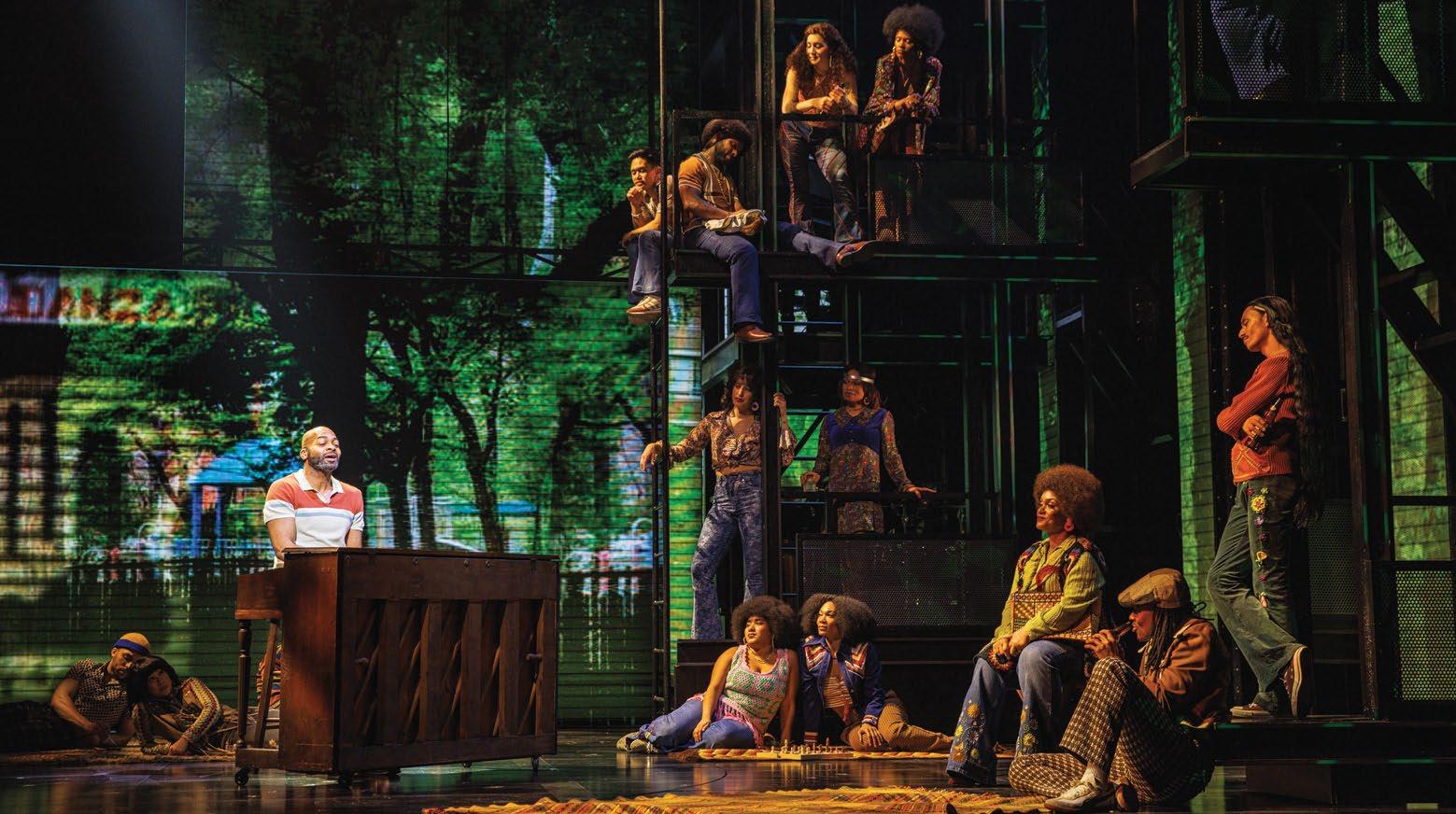
bleating on about for ages, but I didn’t really think it would happen. It was a super-useful feature that I wanted and then suddenly it magically appeared!”
The orchestra is located beneath the stage, bolstered by a handful of musicians visible in a pair of towers adorning the set. Players hear themselves via Sennheiser HD 25 and Sony MDR7509HD headphones plugged into Allen & Heath ME-1 40-source personal mixers. “Not only is the build quality on the mixer absolutely fabulous, but the audio quality and flexibility are hands down better than anything else on the market,” said Owen.
There are also multiple mobile musicians who roam the stage as well, with their playing transmitted via Shure PSM 1000 wireless systems. Not all the stage instruments are real, however; multiple pianos “played” by the actors each contain a speaker, amplifier and Shure PSM 1000 receiver. “The person on stage pretends that they’re playing the piano,” said Owen, “and we beam the sound of somebody who can actually play into it so that the sound comes from the piano; we call them ‘reverse radios.’”
With all that technology brought to bear on a modern-day musical full of hip-hop beats, jazz, old-school R&B, rap and more, Hell’s Kitchen doesn’t sound like a typical Broadway show—and that’s just the way Owen likes it: “The traditional music theater sound for a long time was about pretending that sound didn’t exist. It was all about microphones hidden in the hat, the sound of the orchestra coming out of the orchestra pit and voices coming from the people onstage. A ‘good’ sound design was considered to be one you wouldn’t know was there.
“People go to the movies, hear an orchestra swell around them and they feel it. They put in their AirPods and hear amazing sound, get in their car and hear 29 speakers, or spend $600 at Target on an amazing surround system for their front room—and yet we still go to a theater and pretend like sound doesn’t exist! I realized, ‘No, the world’s moved on. I’m going to stop apologizing for sound.’ I made a conscious decision to take it in a completely different direction, which is a cinematic sound design—so I don’t really do shows that sound like traditional Broadway shows; that’s not really my thing.” Perhaps so, but depending on how his latest Tony nomination—his fifth—plays out, Owen may be founding a new tradition all his own. ■
Indio, CA—Every year, the long-running Coachella festival reinvents itself in new and often surprising ways. At this year’s edition, held April 11–13 and 19–21 at the Empire Polo Club in Indio, Calif., that ethic led to the Do LaB Macrodose electronic music stage launching a new open-air stage design that featured a Meyer Sound Panther line array loudspeaker system.
Eschewing the tent format stages of recent years, Do LaB co-founder Jesse Flemming designed the Macrodose stage as an open-air space dotted with mushroom-like fabric sculptures that provided shade, contained speakers and lights, and allowed crowds to grow and contract without having to be defined by the physical sides of a structure.
Macrodose’s open design and structural elements required a lowprofile sound system that could cover the expanded audience zone, which extended 300 feet from the stage.
Audio crew chief and systems engineer Ian Ingram designed the stage’s sound system and often could be found mixing FOH, much as he has since 2008 when he first provided the stage’s P.A. “We were going for our best options for the position of the P.A. and how much weight the designers should calculate for in their engineering,” he said. “It’s not like a big tent, it’s not like an arena. Only Panther would allow for this kind of rigging with this kind of output on this structure.”
Meyer Sound’s Josh Dorn-Fehrmann worked with Ingram to design a system centered around Panther and the 2100-LFC low-frequency control element. The Do LaB sound system, provided by Los Angeles-based integrator Launch, comprised 10 Panther-L large-format linear array
Wichita Falls, Texas—Wichita Falls’ MultiPurpose Events Center (MPEC), which includes the newly updated Kay Yeager Coliseum, recently updated its aging audio package with a brandnew L-Acoustics A Series sound system.
Able to host up to 10,000 people for concerts, trade shows, sports and more, the venue first opened in 2003, and more than two decades later, its original P.A. system was ready to be retired. With that in mind, the site had a new system installed in February.
The system, designed by Houston-based LD Systems with input from the L-Acoustics Application team, features a distributed design,

loudspeakers flown per side, supplemented by four Panther-W front fills and 18 2100-LFC low-frequency control elements configured in a gradient arc, intended to preserve bass impact while keeping low-frequency energy contained, preventing bleed to other stages.
Beyond that, a half-dozen flown Leopard compact linear line array loudspeakers per side served as delays. The team implemented an outer ring of 10 Ultra-X40 compact loudspeakers as lateral surrounds. The entire system ran on a Milan AVB network and was controlled by Galileo Galaxy 816 and 408 Network Platforms.
Ingram marveled, “I’ve had engineers from other stages come by and say, ‘This sounds great.’ Guest engineers have been really happy with the P.A. and the audience has literally been turning around and thanking me for the audio.” ■

primarily comprising four-enclosure arrays of A15i and a pair of two-enclosure hangs in the end zones—a mixture of Wide and Focus, as needed in each location—backed by a dozen KS21i subs. They are supplemented by six coaxial X8 and two X12 used as a fills for shadowed areas. A combination of 10 LA4X and two LA12X amplified controllers drive the entire setup.
LD Systems engineering manager Anthony DiDonato says the integration of a QSC Q-SYS control system allows the venue to turn speaker clusters on and off as events’ acoustical and seating needs change, keeping sound where it’s
wanted and away from where it’s not, avoiding undesired reflections and reverberation. “It can also drive an auto-mixer when they don’t need to fire up the Allen & Heath SQ-5 frontof-house console,” he said. “It’s a highly flexible system that gets them exactly what they need and at an affordable cost. That’s one in the ‘win’ column.” ■
New York, N.Y.—When Harry Styles spent two years on tour, U.K. audio provider Britannia Row was on-hand for all 169 shows—as was Styles’ guitarist and co-writer Mitch Rowland. When Rowland, now the first artist signed to his famed pal’s Erskine Records, recently hit the U.S. for his own solo tour, the familiar audio company was the first call.
Audio engineer Christian Zuniga was Rowland’s monitor mixer and production manager, working with FOH engineer Miguel Tapia. “The touring band are the same musicians that collaborated on Mitch’s record, which Rob Schanpf, our guitarist, produced,” said Zuniga. They include Matt Schuessler (bass), Schanpf, Aiden Finn (keys), and Sara Rowland, Rowland’s wife.
The tour is running a pair of Allen & Heath dLive CTi1500 desks at both monitors and FOH with DMO MixRack and DX012, fitted with a pair of GigaACE cards for gain sharing. Each console has a Waves card for multitrack recording and virtual soundcheck, with everything running native and no outboard.
“We wanted a small yet powerful footprint that could take us from festival appearances to clubs, as we’ve played some tiny stages such as Pappy and Harriet’s in Joshua Tree, California,” said Zuniga. “Miguel introduced me to Allen & Heath on my previous tour with Mexican pop act RBD. Most of those venues were stadiums and Miguel was mixing on a large format dLive. Apart from being impressed by his mixing skills, I was impressed by the native side of the console with no plug-ins. Everything sounded great; preamps, compressors, reverbs—it was all very powerful.

Once I knew that Allen & Heath make a compact version, mixing on it was a no-brainer!
“There’s very little latency with this console, it has a great layout and fast adaptable workflow. In previous meetings with Mitch and Rob, they wanted to produce a show that sounded like Mitch’s record, Come June, with analog tubes, and so on. An analog system was out of the question due to venue size, but we were very pleased with how this sounded.”
Zuniga uses Shure PSM 1000s for the Rowlands with JH Audio Roxannes, while the rest of the band opts for d&b audiotechnik wedges. “Mitch and Rob are very particular with their guitar sounds,” he added. “We travel with two vintage Ampeg Geminis and a vintage Fender Custom Deluxe for their rigs. We use a mixture of Shure KSM32 and beyerdynamic M60 mics, with the vocal mic being an sE Electronics V7. It gives the clarity needed to push Mitch’s vocals out of the mix.” ■
Nashville, Tenn.—Live sound engineer Bruce “BK” Knight passed away Monday, April 22, 2024, after suffering a double aneurysm and a stroke. Over the course of four decades, Knight mixed a who’s who in rock and pop, building a touring resume that included household names across a variety of genres. An in-demand engineer, Knight was as well-known in the industry for his calm, upbeat attitude and insightful conversations as he was for his talent behind the desk.
Knight toured with a broad range of artists over the course of his career, including Sheryl Crow, Don Henley, Aerosmith, The Smashing Pumpkins, Prince, Faith No More, En Vogue, Richard Marx, Alice Cooper, The Doobie Brothers, The Black Crowes, Bob Seger and the Silver Bullet Band, Expose, Garbage, REO Speedwagon, Lyle Lovett and plenty of others.
“I have mixed a lot of different types of music over the years because I’m always ready for a new
challenge and I feel there’s always something new to discover and bring to the table from each experience,” he told Pro Sound News in a 2004 interview. “I’ve definitely learned something great from every artist and every situation that I’ve worked in, and there’s always more to be learned.”
Born May 9, 1963 in Cedar Rapids, Iowa, Knight picked up the guitar briefly as a pre-teen
 By Clive Young
By Clive Young
before discovering he was far more interested in getting behind a mixing desk. “I just kind of got frustrated with trying to learn from note to note, never really wanted to perform or had the desire to be on stage, and found it more fascinating behind the scenes in audio,” he said. As a result, by the time he was 16, he was mixing local acts, and after high school, attended The Recording Workshop in Chillicothe, Ohio, to develop his skills. Starting in 1982, Knight joined Chicago’s dB Sound, where he was mentored by owner Harry Witz, building his career as an FOH engineer and system engineer on numerous tours before going freelance in 1993.
Knight and touring proved to be a good match. “I love touring in Europe,” he said in 2004, “because I’m into the architecture, the history and especially the cuisine. It’s some of the best in the world! As a ‘foodie,’ my big weakness is probably red wine and espresso.” ■

In our annual studio design issue, we present 18 of the most exciting new or refurbished studios to open over the past 12 months—from some of the world’s top studio designers.


Studio Design: Horacio Malvicino, Malvicino Design Group
Sony 5020 Studios Madrid is Spain’s largest recording studio, housed in a 20,000-square-foot, three-story building that was designed to be a European version of the famous studio located in Miami. It features production rooms, recording studios and large workspaces, as well as audiovisual and photographic content creation areas, leisure and relaxation lounges and event spaces.
The studio is divided into three thematic zones that are designed to serve multiple purposes, the first being a collaborative floor that includes a welcome hall; two composition, recording, and production rooms; a set for audiovisual and photographic shooting; different work areas; a meeting room; a coffee area; and a lounge for rest and relaxation.
The next zone is a premium floor that features two recording studios, each with an ISO booth; a media room that can be converted into a movie room; private rest and entertainment areas; a professional kitchen; and an 85-square-meter live room that can be transformed into a space for indoor events or a dining room for catering.
Finally, the rooftop third floor is for outdoor celebrations or for anyone needing a space to relax or create. This rooftop is nearly 500 open-plan square meters with a bar, a grill, a Josper oven, a covered pergola dining room and a stage for musical performances.
Though it opened in January 2024, 5020 Studio Madrid has been fully operational since November with the help of Sony Music. The studio represents the beginning of the 5020 Studios network, which includes Miami and Mexico City and plans to expand to other major global cities such as Sao Paulo and Buenos Aires. The goal of the network is to create a global creative community that enriches and supports artists, musicians and creators. The facilities are designed to provide a conducive environment for artists, musicians, sound engineers, music producers and collaborators to meet and create together.
This project was co-directed by Sony Music Latin Iberia and Sony Music Spain, along with Malvicino Design Group for acoustic design and system integration, EZ Acoustics for project management, Zazar Architecture, Ribba Estudio for interior design, and Diego Acosra, project director for Sony 5020.
Studio Design: Wes Lachot, Wes Lachot Design Group
Suntone Recording Studio began as a total rebuild (by Greenline Architecture) of an existing building that expanded into a bigger ground-up project, and is part of a larger arts complex that includes ArtStryngs Gallery. The Reflection Free Zone control room is designed around an API 2448 console and ATC SCM150A Pro monitors, with 15-inch subs, and Brett Acoustics clouds and diffusors, creating a naturalsounding control room that is not too dead yet is very accurate for mixing. The 600-square-foot live room features the recently patented Hexaffusor ceiling clouds designed by Wes Lachot and Dr. Peter D’Antonio, and variable acoustic walls for control over room ambiance. The preponderance of wood in the live room creates a natural warmth and keeps the room from sounding too over-absorptive. Acoustical installation and finishes by Brett Acoustics; technical wiring by Canova Audio.

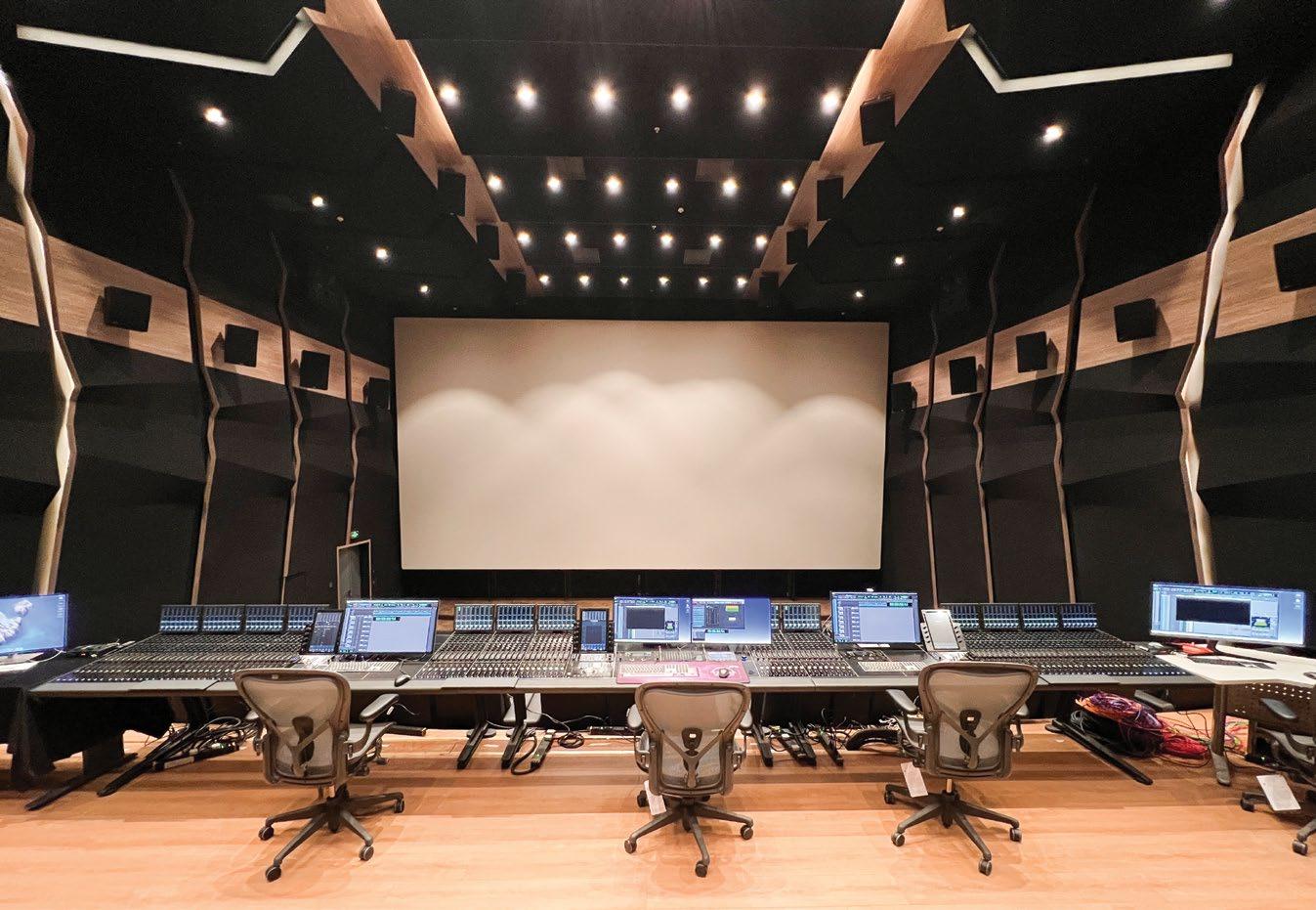
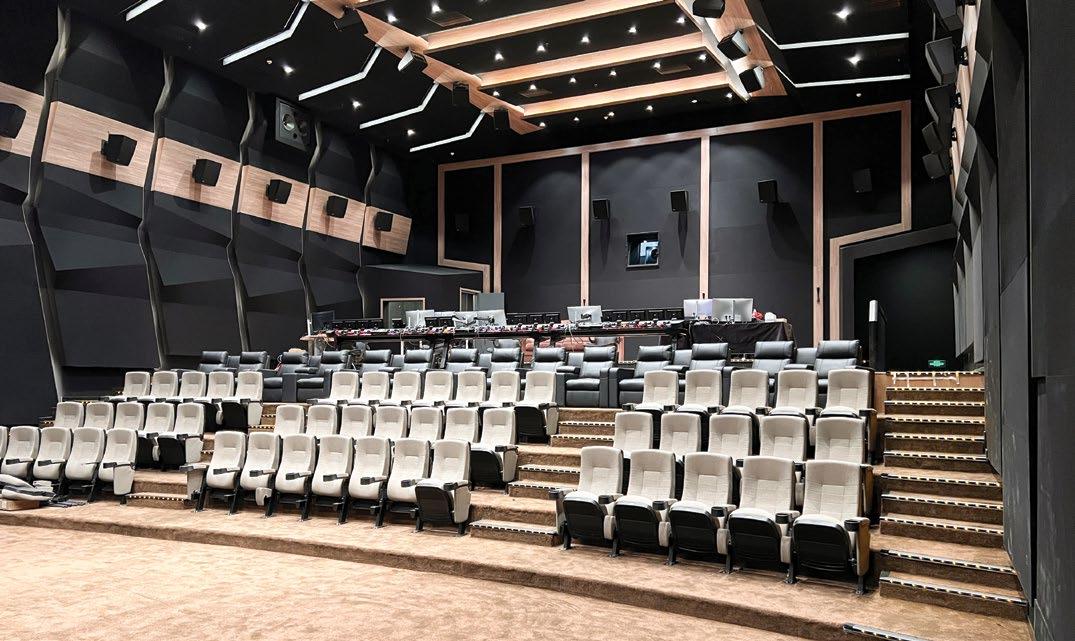
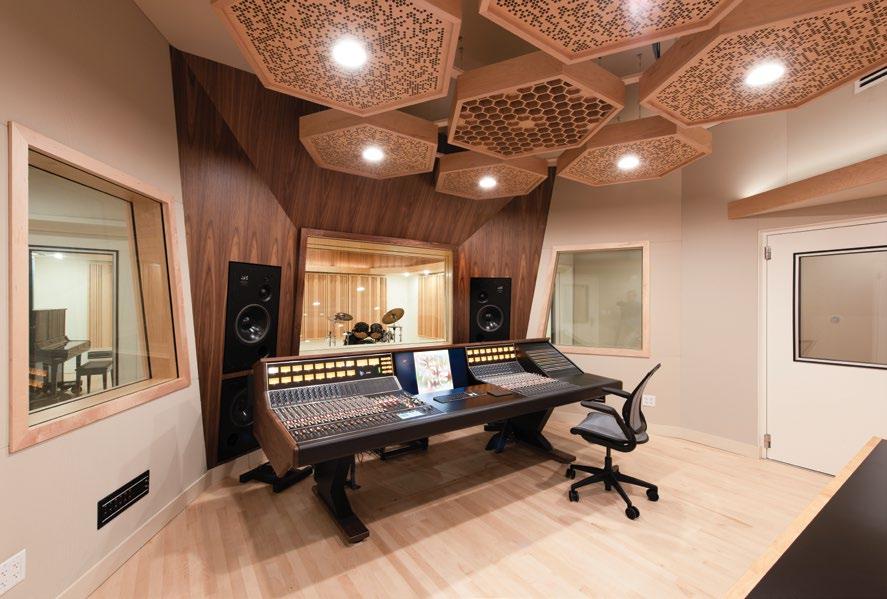
Studio Design: WSDG (Walters-Storyk Design Group)
Since its creation in 2008, Beijing’s Huairou District has emerged as the hub of China’s film production industry. Spread across 150,000 square meters of prime real estate, the Huairou District is considered “Mainland China’s Hollywood” and is home to leading firms in virtually every area of professional filmmaking—with the exception having a stateof-the-art Dolby Atmos film audio mixing theater. That omission has now been addressed. A productive collaborative relationship was established with WSDG China-based representative Víctor Cañellas and WSDG partner/project engineer/liaison, Sergio Molho. WSDG partner/art director Silvia Molho was also brought onto the project. The facility opened in January 2024 and features a full complement of 60 speakers—including Meyer Sound HMS-10, HMS-15 and X-800C, as well as Acheron 100, LF and HMS-12 models—that support the Dolby Atmos system. The CFG Mixing Theater is based around an Avid S6 Console.

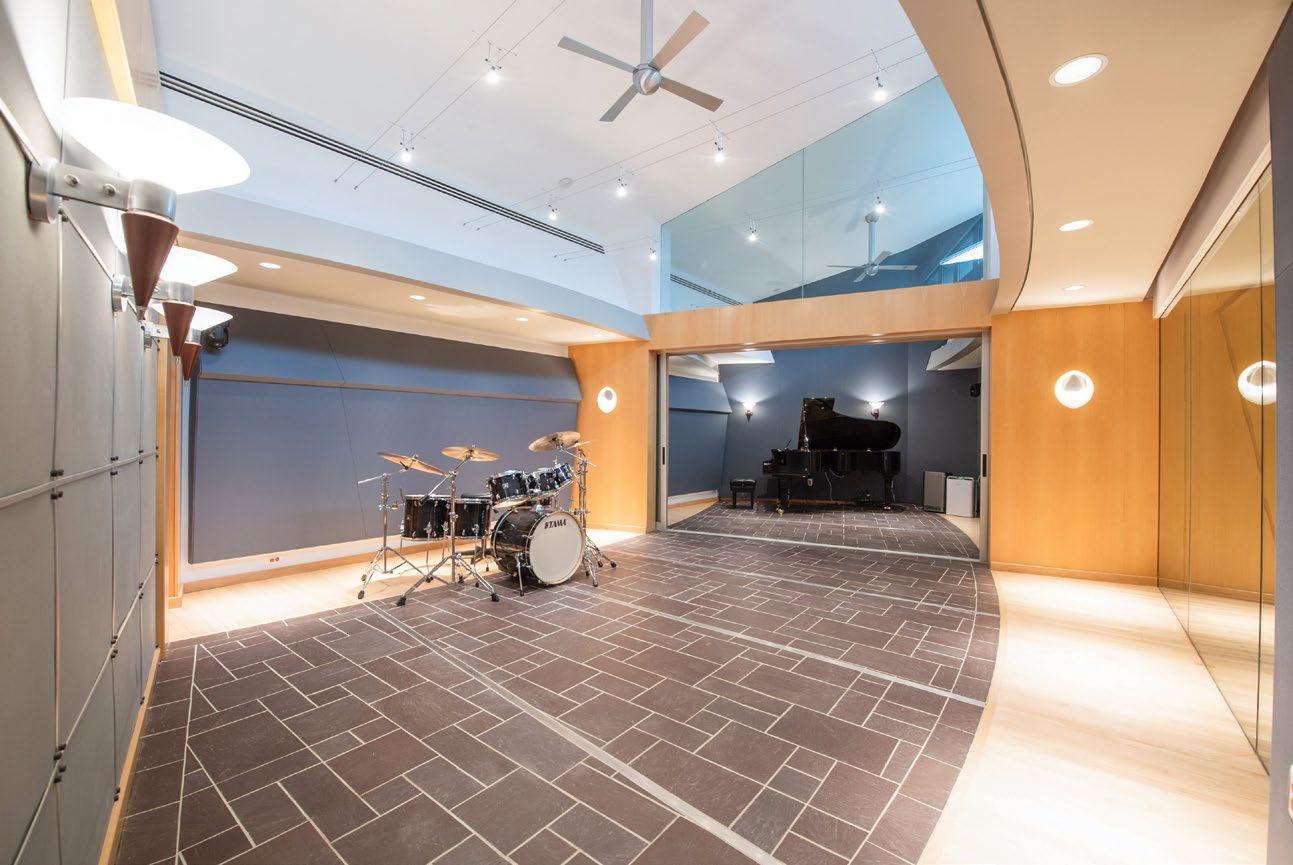

Studio Design: Russ Berger, Mark Hornsby, RBDG
Originally designed to accommodate recording artists Whitney Houston and Bobby Brown, Crossway was decommissioned in 2012 after Houston’s untimely death. The new owner, Hal Cohen, hired the original designer, Russ Berger Design Group, to restore and replace the decorative and acoustical finishes, replace and upgrade acoustical core materials, rebuild and replace all the millwork items—LMTs, credenza, patch bay garage—and adjust and redesign the acoustical treatments to accommodate a new Dolby Atmos monitoring system and rework floor troughs to restore access to an underfloor technical wire management system. There are unique architectural features everywhere you look that serve critical acoustical functions, including sintered aluminum acoustical elements, and a 13-feet wide, 7-feet high, ¾-inch sloped sound rated laminated glass that disappears into the isolated, woodfinished floating concrete floor between the control room and studio. The need for bass trapping in the upper volume at the rear of the control room led to the creation of a large diagonal millwork beam that transects the control room and extends into the studio, where it divides the piano room from the main studio.


Studio Design: Carl Tatz Design
Paul Sidoti opened Scarlett Sound Studio in April 2024 based around an Avid S6 M40 24-9-D console, Avid MTRX II and Avid Pro Tools MTRX Studio, with a hefty collection of preamps and outboard gear that includes a pair of Undertone Audio MPDI-4, API 3124V, twin API 512V units, two API 550A, API 550B, API 560, a pair of API 527, API 2500, Universal Audio 1176LN, Universal Audio LA-2A and an Empirical Labs Distressor EL8-X. Designed by Carl Tatz, the studio includes a Carl Tatz Design PhantomFocus 9.1.4 Dolby Atmos MixRoom Studio with SoundExpansion tracking room, OD booth, amp closet and client lounge.
San Juan, Puerto Rico
Studio Design: Jeff Hedback, HD Acoustics
Jeff Hedback and client Alfredo de Matteis-Colberg began designing this destination studio in 2014, with a vision of calling back classic 1970s Caribbean studios with large spaces and musicians tracking live off the floor. Ten years later, Estudio Medea is open. The first level of the ground-up, two-story building contains Studio A with a 550-square-foot Control Room, 950-squarefoot Live Room, Booth, Lobby and Machine Room. The second level features the 450-square-foot Control Room B and office space. Hedback utilized advanced acoustical modeling and simulation methods to shape the control room and design the tuned perforated MDF wall systems that are displayed in a striking blackmatte finish. The rear wall of Control Room A displays Hedback’s ARG Diffs, while the front of the room is excited by the flush-mounted custom AudioKinesis mains. The Live Room features custom-designed sequences of reflective half-cylinders, allowing clean captures of large ensembles with a “dense, rich” room sound.

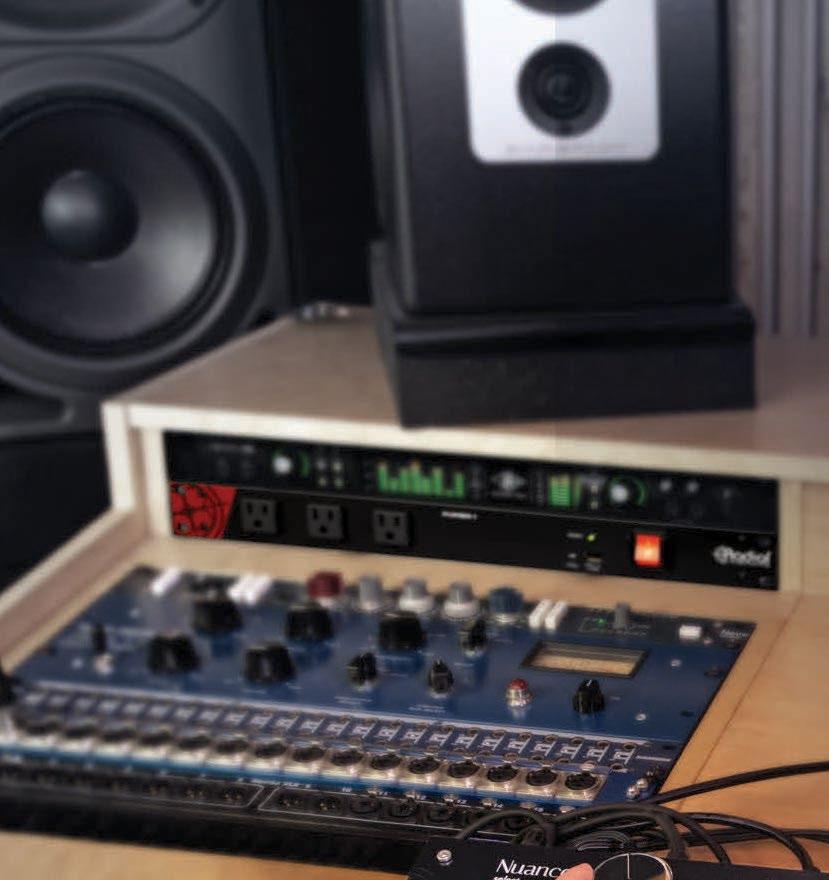
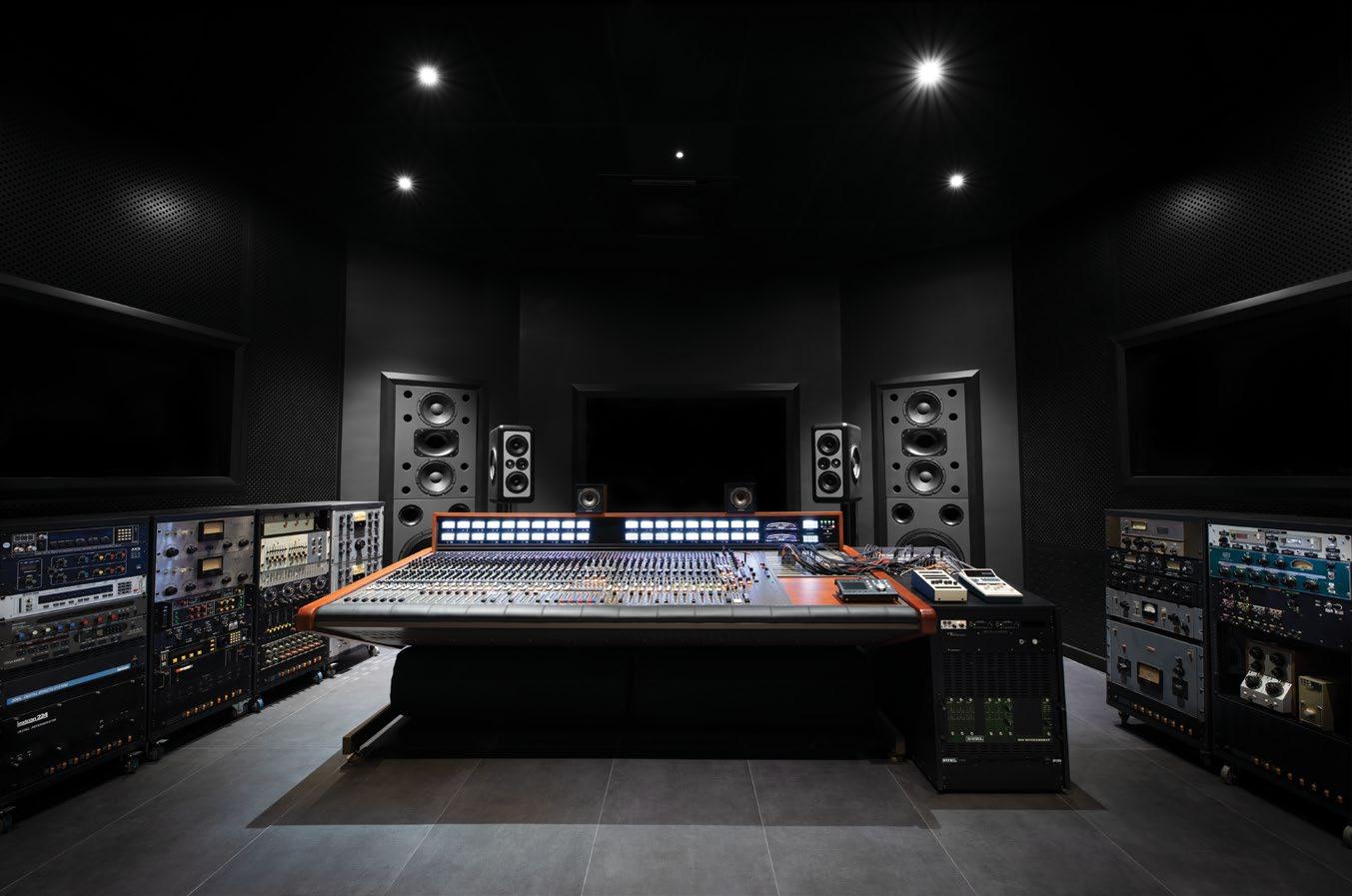










Toronto, Ontario, Canada
Studio Design: Martin Pilchner, Pilchner
Schoustal International
Songsbury, a recording studio and creative suite for producer Mat Teofilo, features a 400-square-foot control room, 420-square-foot live room, and 80-square-foot iso booth. The control room uses controlled reflection geometry to provide a smooth and uniform response for the ATC main monitors and Genelec 7.1.4 Dolby Atmos monitor system. The studio proper leverages high ceilings and a variety of treatments to provide varying sonic opportunities throughout the space. The neutral finishes provide the blank canvas for the art of performance to unfold. The studios are built in a commercial space outfitted with kitchens and lounges, offering homelike comfort for artists. In addition to the client amenities, the facility also features a separate podcast studio.



Studio Design: Gavin Haverstick, Haverstick Designs
This luxury, private mixing/mastering/recording studio features a 9.2.6 Dolby Atmos-enabled Studio A (all PMC speakers with an Avid S6 console and accompanying Studio B that can double as an isolation booth for Studio A. The adjacent video cyclorama room is also tied into the studio, providing flexibility to serve their clients for any creative project. Haverstick Designs worked with owner Jordan Bolch, along with team members Richie Schwab and Patrick Collier, to design his dream studio, which included full construction plans for sound isolation and 3D renderings, and CAD specifications for the fully custom bass trapping and stretch fabric system that was utilized throughout the studios. Gear selection and integration was handled by Frank Verschuuren, Cedric Yee and Michael Carnarius of Vintage King, and Bob Mondok of Sweetwater.

Studio Design: Peter Grueneisen, nonzero\architecture
This new production facility, built into a historically significant building, includes a main studio placed inside an existing sound stage, allowing for ample room height and the installation of a 9.1.6 Dolby Atmos monitor system. Floating concrete slabs and room-in-room construction throughout are employed for maximum sound and vibration control. The adjacent tracking room and iso booth feature an even taller ceiling than the control room. In all rooms, fabric-covered walls are visually warmed up by vertical wood slats, calibrating the acoustic performance in each space. Hardwood floors complement the palette throughout the studio areas. The design concept references the history of the building as a former helicopter assembly and repair shop, with a hint at the location near the Santa Monica Bay and the proximity of the ocean. Acoustic design by Charles Salter. System design by ASG and Vintage King.

Studio Design: Carl Yanchar and Rich Avrich
Film composer Joe Trapanese opened this private facility in January with three control rooms, a live room, vocal booth and common areas. Control Room A is a 7.1.4 Atmos mix studio featuring Bryston amps, JBL speakers for LCR, four Sunfire subwoofers, and Kali Audio surround and overhead speakers. Control Room B is a 3.1 room with JBL speakers and Sunfire subwoofers. The control rooms share a live room with a motorized drumbrella for variable acoustics. Control Room C is a smaller writers’ room with an attached vocal booth. All rooms are connected to a central machine room, which houses the Pro Tools HDX systems, syncing, Bricasti reverbs, networking, security, and backup. The facility has generous amounts of Cat-6a throughout. This provides futureproofing for all rooms and facilitates flexible audio or video routing. Audio can also be transferred between studios through analog tie lines. The studios have a consistent aesthetic that features custom fabric walls, stained oak reflective surfaces and trims, and ample bass trapping.
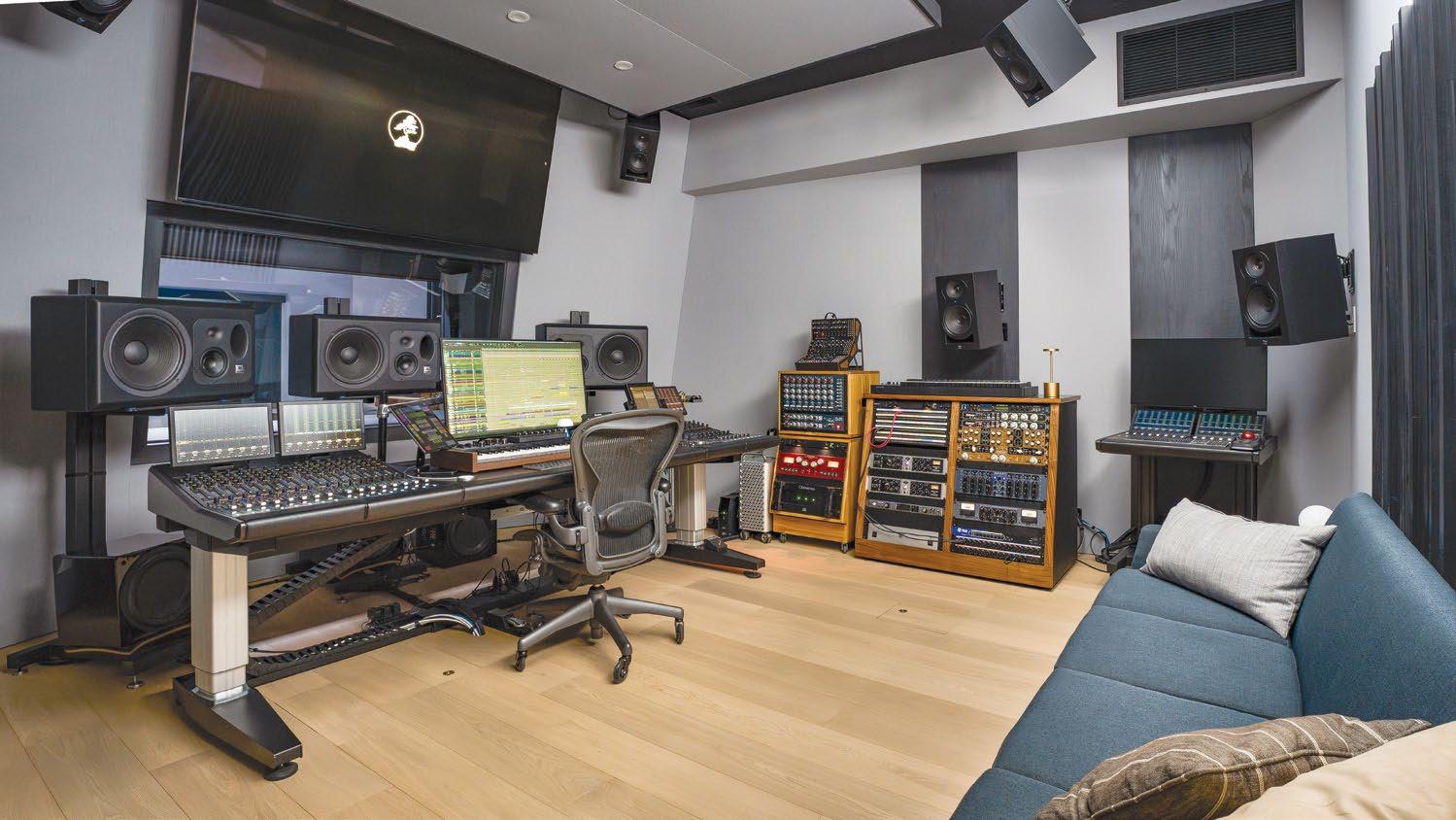












Studio Design: Dave Malekpour, Malekpour Design Partners


Antenna Studios, the home base of EDM Music group Memba, was designed to be an inspiring creative space with a range of instruments, synths, and production gear that would appeal to multiple users. The 700-square-foot studio suite in Brooklyn’s Greenpoint neighborhood includes an 18x24-foot room with 10-foot ceilings, with a 12x14x10-foot booth that has a window with a nice view. Acoustic design was created with Jocavi Acoustic Simulation to predict the room response and design the treatments to optimize the room. The Jocavi WallTrap bass traps are tuned to specific low frequencies and are arranged across both walls and ceilings, front to back of the room, providing linear response anywhere you stand. Isolation was designed using the Studio Float IsoRaft decouplers floating the walls, floor and ceiling in the studio.
Studio Design: WSDG (Walters-Storyk Design Group)
High Mountain Record Studios consists of two sections—Studio A with a 50-squaremeter live room and Studio B with a 20-square-meter live room. Both are outfitted with geometrically identical 33-square-foot control rooms. Studio A is devoted to owner Lucas Gleich’s independent recording and mixing projects, while Studio B is available for thirdparty clients. Studio gear includes an API 2448 32-channel console and two ATC SCM150 PRO loudspeakers, each complemented with an ADAM Audio SUB15 subwoofer. For Studio B, the main studio gear includes an Universal Audio X6 interface and Burl B16 AD/DA converter, and Heritage Super 8 and API preamps, as well as PMC 6 monitors. A Dante network expedites high-quality remote recording of live performances from the Festspielhaus Concert Hall.
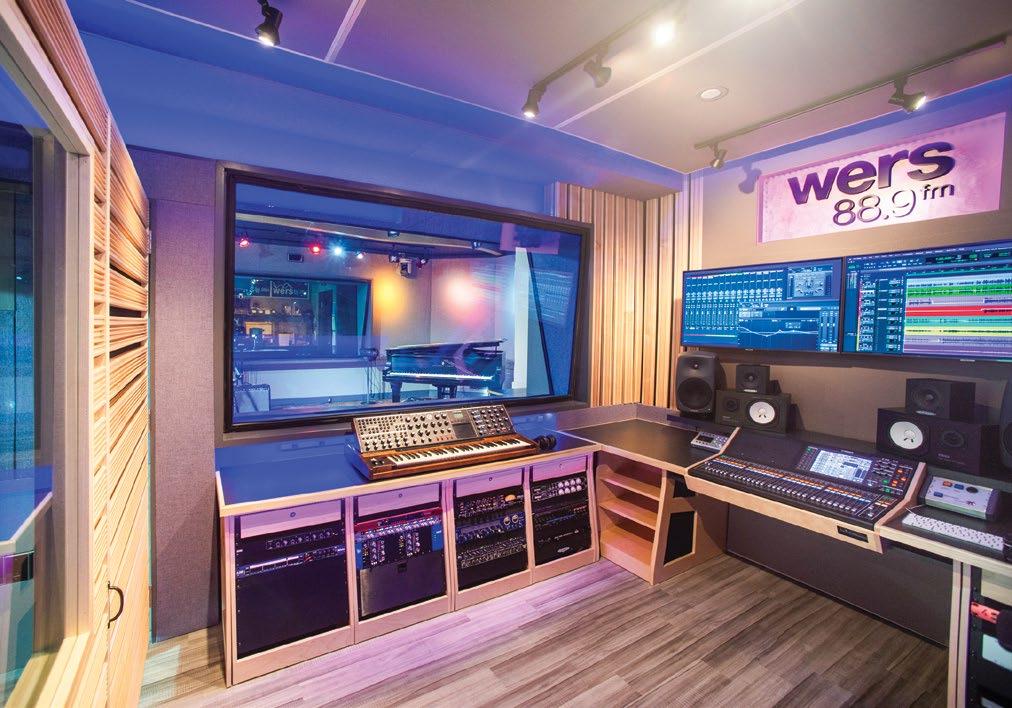
Studio Design: Lou Clark, Sonic Space
This control room was completely renovated to maximize current footprint to encourage a more hands on experience for students and clients at Emerson College. The main unique feature is a custom gobo mounted on hinges, attached to the wall, that may be deployed to create isolation between the engineer and performer. A glass window is built into the gobo for optimal viewing. This window, when in its closed position, allows for a video screen to be visible. The ceiling has roughly four feet above it for broadband sound control. It consists of soffits around the perimeter and a large ceiling cloud that can be dropped down for servicing of equipment above the cloud. All the furniture was custom designed and built to suit the workflow needs of the space.

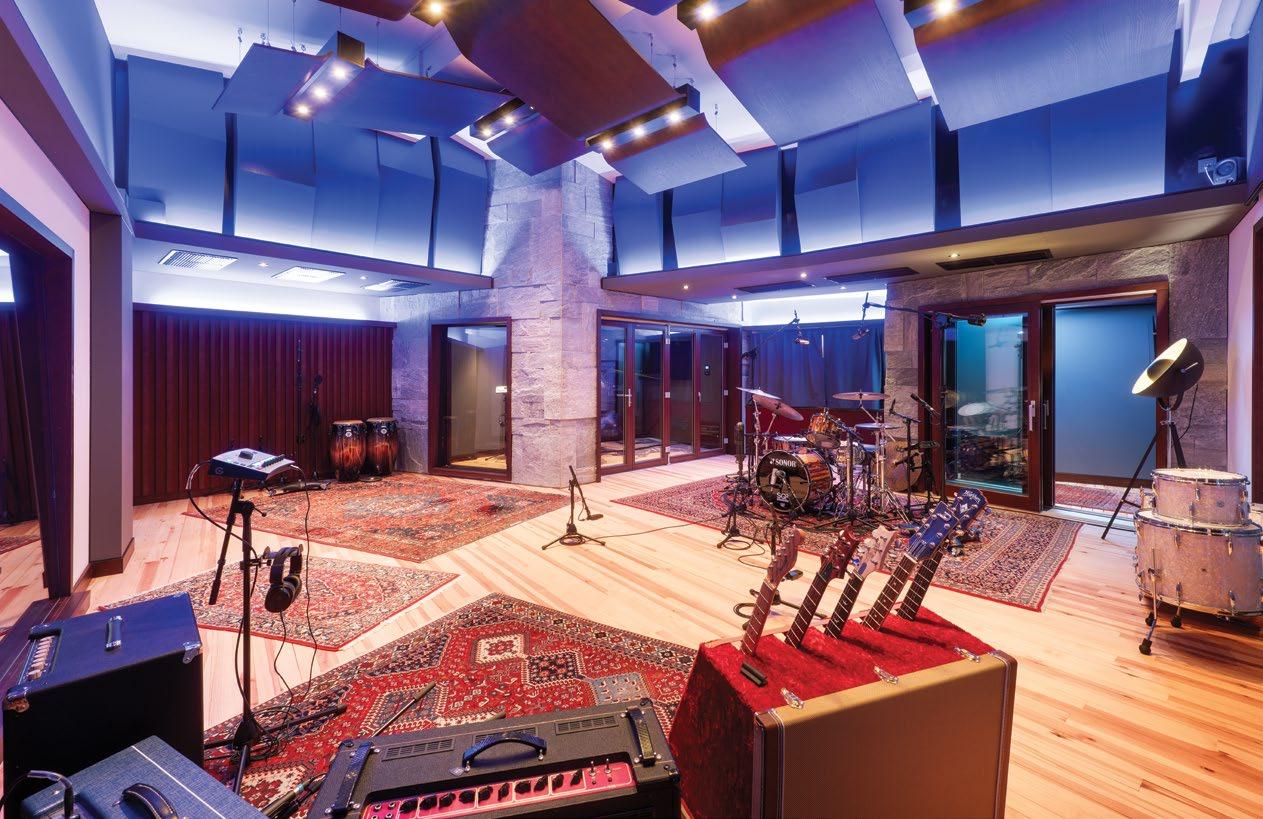
 PHOTO: Alex Gretter
PHOTO:
Timothy Gaudreau
PHOTO: Alex Gretter
PHOTO: Alex Gretter
PHOTO:
Timothy Gaudreau
PHOTO: Alex Gretter


Studio Design: Jeff Hedback, HD Acoustics
Studio Design: Gavin Haverstick, Haverstick Designs
In early 2023, director of Studio Operations Danielle Engen and chief engineer Nick Mac reached out to the Haverstick Designs team of Gavin Haverstick, Oscar Otero and Tracy Roberts to coordinate a full renovation of the space with their general contractors, Pacific Southern Development. The Studio A Control Room received a monitor upgrade (soffit-mounted Genelec 1235A speakers and Genelec 7382A subwoofer) and a major reworking of the front wall soffits to improve sound isolation, accurate positioning and to ensure that the performance of the speakers was optimized. The existing stretch-fabric system was revitalized, along with new ceiling clouds constructed and installed by Nyback Builds. The versatile Studio B received upgraded wall/ceiling treatment, including a beautiful wood slat bass trap on the front wall, also built by Nyback Builds. Enhancements were also made to the lobby, iso booths and production rooms, giving this historic studio a fresh new look and sound.
Owner David Lee’s Wallbanger Studio is a 1,100-square-foot, three-room (control room, booth, and video production) studio located within a 10,000-square-foot metal building. The live room comprises roughly 3,000 square feet of the open space with multiple gobos for control. The 650-square-foot Control Room features bold black and red fabrics with natural stone segments. The warm feel of the finishes is contrasted by the striking custom metalwork desk and speaker stands built by Doug Burns. Acoustically, the room features custom low-frequency absorbers and diffusers designed by Hedback. The flexibility in room layout, sound isolation and technical wiring design allows all spaces to work in unison (including the capture of audio and high-resolution 4K video), to function independently, or any combination thereof.
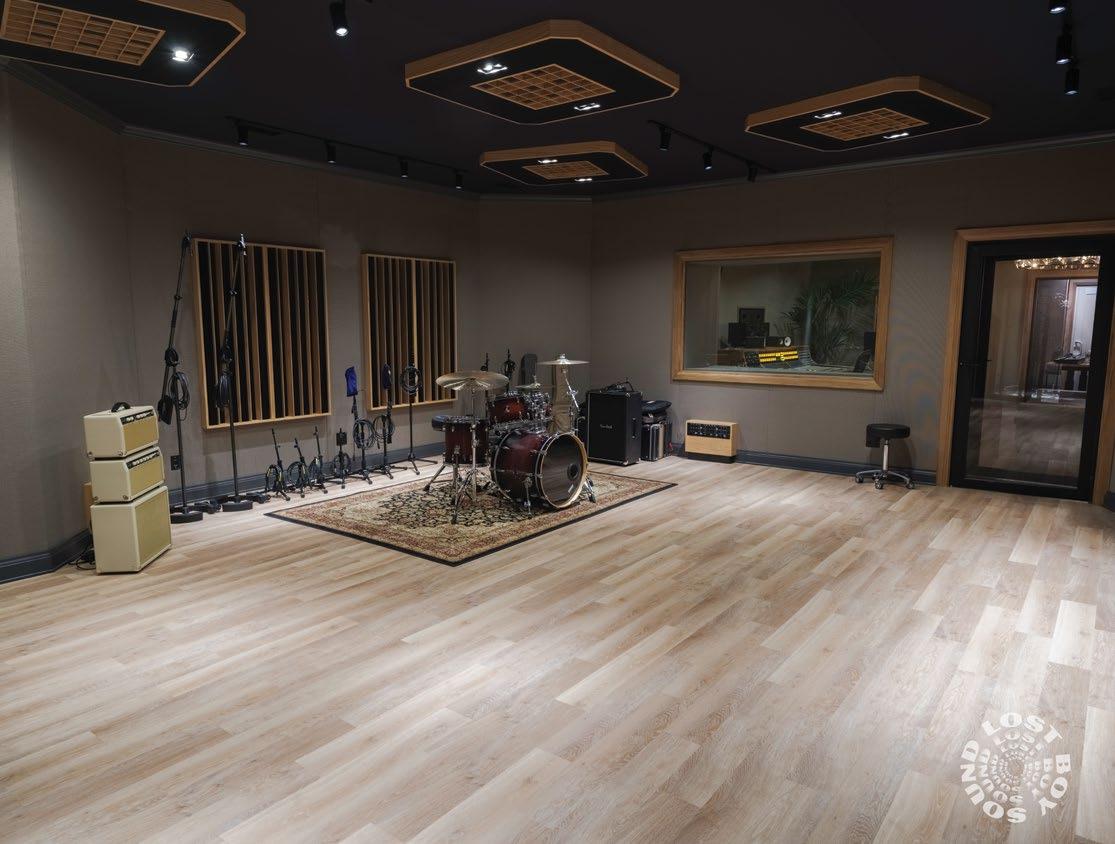
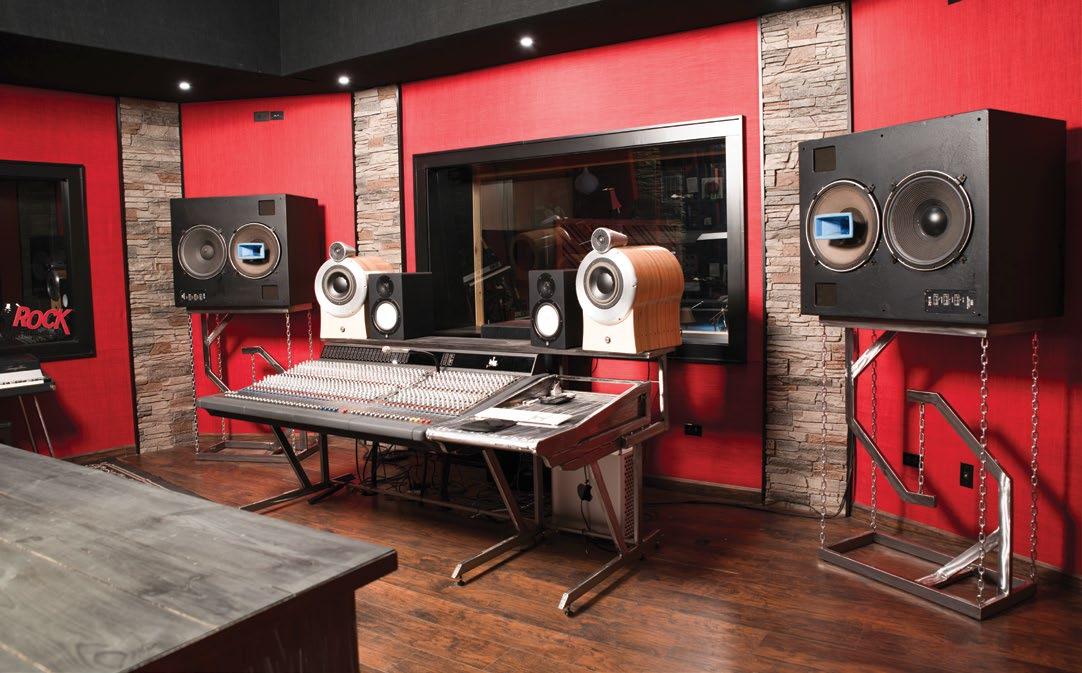

Studio Design: Horacio Malvicino, Malvicino Design Group
The brainchild of trader, investor and real estate developer Evan Meador, a talented guitar player and songwriter, this state-of-the-art studio located in the heart of Chicago’s West Loop has a spacious sound and comfortable vibe, making artists feel at home. It features a large control room based around an API 2448 32-channel console with automation; Pro Tools HDX with Avid MTRX and UAD 2 October Satellites; and Quested VH3208 main monitors, with ATC SCM 45A/ SCM0 nearfields. An ample live room features MDG’s variable acoustic panel system that offers a flexible acoustic environment for recording live bands. An associated iso booth with sliding doors can accommodate overdubs and a small drum kit.

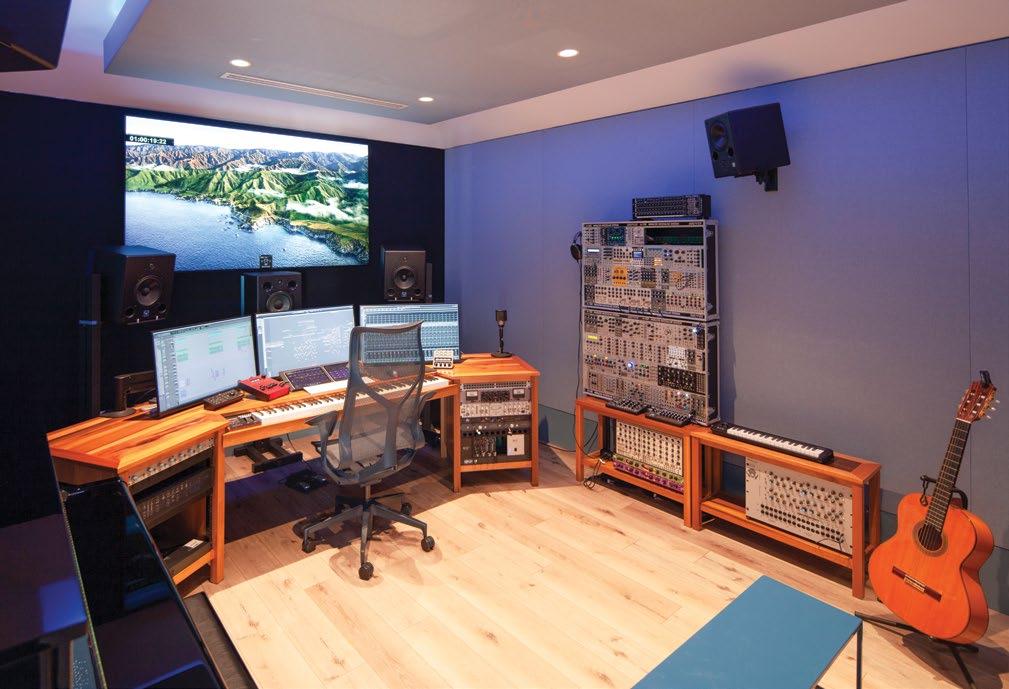
Los Angeles, Calif.
Studio Design: Peter Grueneisen, nonzero\architecture
Studio Design: Russ Berger, Mark Hornsby, RBDG
This creative production facility is housed in the iconic Crescent Building at the foot of the Sherman Hill neighborhood in Des Moines, Iowa. Studio A is a spacious control room equipped with a state-of-the-art 7.1.4 Dolby Atmos Genelec speaker system. The studio features a digital S4 control surface and a 16-track 2-inch tape machine, along with top-tier compressors, EQs and preamps. The second isolation room is a 175-square-foot space perfectly suited as an additional tracking studio with a view of the control room. Studio C is ready for video editing, audio mixing and color grading, with the added dimension of Dynaudio 5.1 surround sound. Studio D, the live room, is just shy of 1,000 square feet, equipped with track-mounted white, black, green, and blue curtains able to be positioned for any shooting need and sound control.
The Toy Box Music studio takes the ubiquitous Los Angeles garageconversion studio to another, more professional level. Relocated by owner Toby Chu from a commercial studio space to this new location, the facility is both more spacious and more elaborately detailed than its predecessor. Given the compact size of the studio and the streamlined layout of the equipment and furnishings, the design is kept minimal, with all acoustic elements and wiring concealed behind light blue fabric panels. The existing sloped roof is being used for air conditioning ducts and cove lighting, while it is capped off with a floating ceiling cloud, covered in fabric.

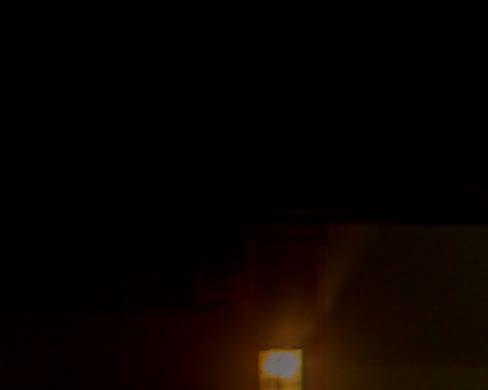

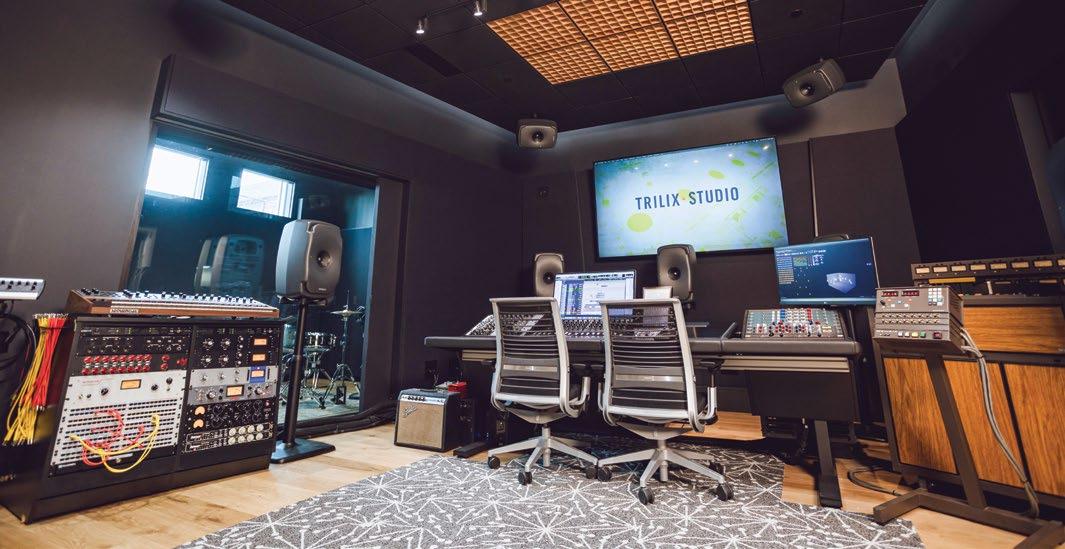













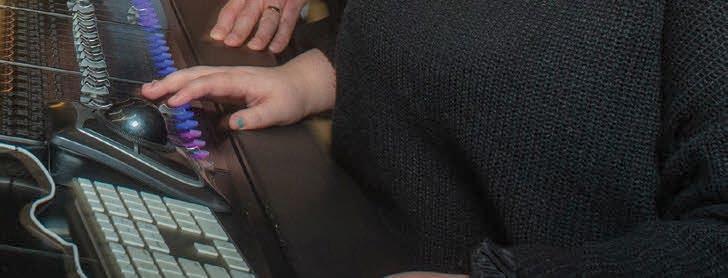


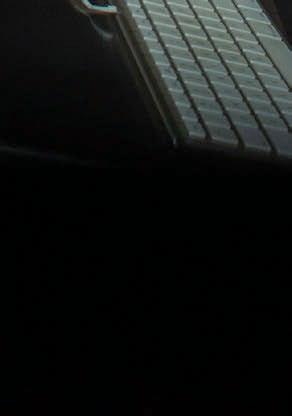














University of Miami’s world-renowned Frost School of Music opens a gateway to the future of music creation and performance
 By Jeff Forlenza
By Jeff Forlenza
Music has been an integral part of the University of Miami since it opened in 1926 with two academic units: the College of Arts and Sciences and the Conservatory of Music. Nearly a century later, that commitment to music has been updated for the next 100 years with the November 2023 unveiling of the Frost School of Music’s new Knight Center for Music Innovation.
Designed by H3, an Arquitectonica Company, the 25,000-square-foot facility includes two performance spaces: the Newman Recital Hall, an intimate 200-seat performance theater with superior acoustics, and the Thomas D. Hormel Music Innovation Stage, a spacious, configurable room for a multitude of musical performance
possibilities. “I don’t know if there is a space in all of South Florida where chamber music will sound better than the Robert and Judi Prokop Newman Recital Hall; it’s just a pristine listening experience,” says Reynaldo Sanchez, Associate Dean for Strategic Initiatives and Innovation, professor at Frost School of Music and a music producer. “This journey began all the way back in 1965, when Bill Lee was hired as Dean, and we started all these cool programs that we have now. Our music engineering program was launched in, I believe it was 1977 or ’78, and we were the first in the country!”
William “Bill” Lee was the music school Dean from 1964 to 1982. In 1976, he invited Nashville sound engineer Bill Porter—known for recording hits by Roy Orbison, the Everly Brothers and Elvis Presley, among many others—to help shape the

early Music Engineering Technology program at the Frost School of Music. Ken Pohlmann, a former Mix columnist, taught one of the first university-level courses in digital audio in the mid-1970s, and became a guiding force in the early music engineering curricula.
Construction of the Knight Center, meanwhile, was driven by Frost’s current Dean, Shelton “Shelly” Berg, an award-winning jazz pianist and composer himself, who pushed for superior room acoustics and technological innovations. He was assisted by Associate Dean of Administration at Frost, Serona Elton, who pulls double-duty as Director of the Music Industry Department.
“I was hands-on in working with the various teams that are outside of Frost to get the building fully operational,” Elton explains. “The

building has two large event spaces that serve very different purposes. One end of the building is the Newman Recital Hall—a beautiful, visually stunning hall that is meant for acoustic music. It’s a more intimate space. At the other end of the building is the Hormel Music Innovation Stage. It’s not a stage in the traditional sense; it’s this very versatile space that can be used for a variety of different kinds of events. Calling it a multipurpose room is sort of an understatement because it’s so much more interesting than that: You can put on a rock concert in there. You could create a jazz club vibe. You could also have a conference session.
“Each of those two event spaces have their own audio control room, as well as a separate video-lighting projection control room,” she continues. “There are also supporting spaces

in between the rooms—a green room, several dressing rooms, and a practice room—and most of the rooms are networked in some way, whether it’s that they have a monitor on the wall that has a live feed from another [performance space], or they’re fully wired into and could be used for recording somebody in those spaces.”
“There are actually two buildings there,” says acoustician Russell Todd of Akustiks, South Norwalk, Conn., who, along with partner Paul Scarborogugh, has acoustic design credits that include Nashville Symphony Hall and the David Geffen Hall at NYC’s Lincoln Center. “The best way to think of it is as a barbell. You have the Newman and the Hormel, and between them is this bar with all the mechanicals serving the hall—the elevator, air conditioning, all the mechanical noise—on the roof of the lobby between the recital halls so that noise or vibrations can’t cross over to either recital hall.
“In Newman Hall, the ceiling averages about 40 feet,” Todd continues, “and it’s a tilted roof, which helps to keep energy forward in the room. The side walls that are adjacent to the audience are very specifically shaped to provide lateral acoustical reflections. I’m a New England guy, and it comes from the design of traditional boat hulls—planks that are bent and curved. I discussed this with [principal H3 architect] Ariel
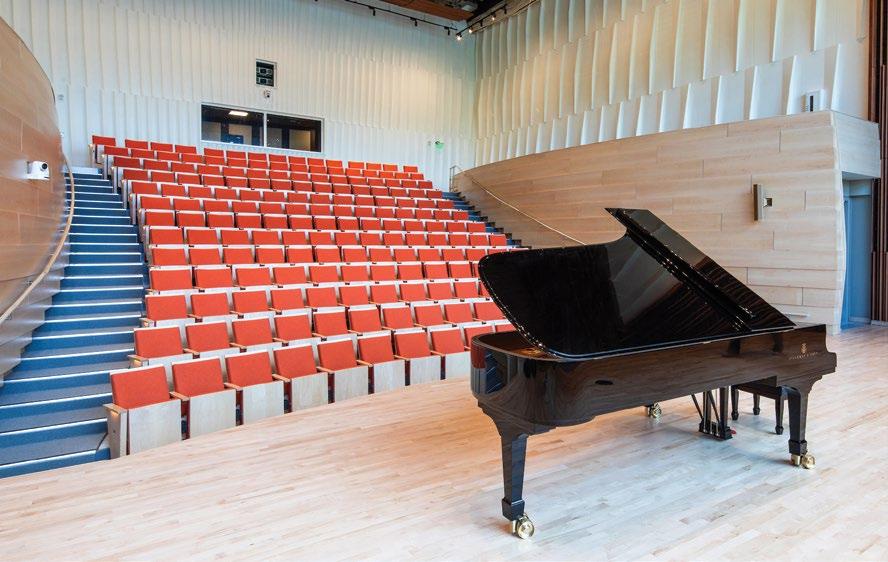
Fausto, and that’s the architectural inspiration. The walls are compound-curved in sections, and it sends some of that energy into the upper, reverberant chamber of the room, and decreases the harshness to the audience.”
One of Dean Berg’s requests/visions for the Newman was the addition of a pipe organ, but not just any pipe organ. “At the very outset, Dean Berg wanted to have an organ in the space, an electronic organ specifically,” Todd says. “We worked with Marshall and Ogletree to design how that Opus digital organ would be integrated into the room seamlessly. Ariel Fausto designed that wood facade in a way that looks like a pipe organ. The geometry of it—the wood slats as pipes going up—gives the visual impression of a pipe organ, and all of the drivers for the electronic organ reside behind the wood walls that flank the stage.“
Frost Director of Production Services Dana Salminen especially appreciates the adjustable acoustics in Newman Hall: “On the left and right sides of the hall, you have acoustic curtains,” Salminen notes. “We can raise and lower to adjust the acoustics in the room, primarily to simulate an audience when somebody is having a rehearsal and the hall is empty. Those curtains

are meant to simulate what that hall is gonna sound like when it’s full of people.”
“What’s neat in Hormel,” Salminen says, switching gears, “is that we have a pipe grid across the ceiling where we can hang additional cameras, lighting projectors, whatever’s needed for that specific event, as well as having lots of different power and data connections at all different locations. That’s the whole point of this space: We did not want to be locked into any specific orientation or a way that everything had to be set up.”
Sanchez adds, “This room could be configured
any way we want for musical performances, but it’s also great for immersive multimedia experiences. We have walls we could project onto. The floors and the ceiling are black and the walls are white, and there’s no fixed seating.”
Other Hormel Innovation Stage use cases include orchestral scoring to picture, as it can hold an 80-piece orchestra, and it has projection, lighting and networking capabilities. One difference between the two performance spaces from an acoustical design perspective was the creation of glass walls that would also serve as projection and broadcasting locations.
“The glass wall in Hormel is tilted, and in Newman, it is not,” says acoustician Todd. “In
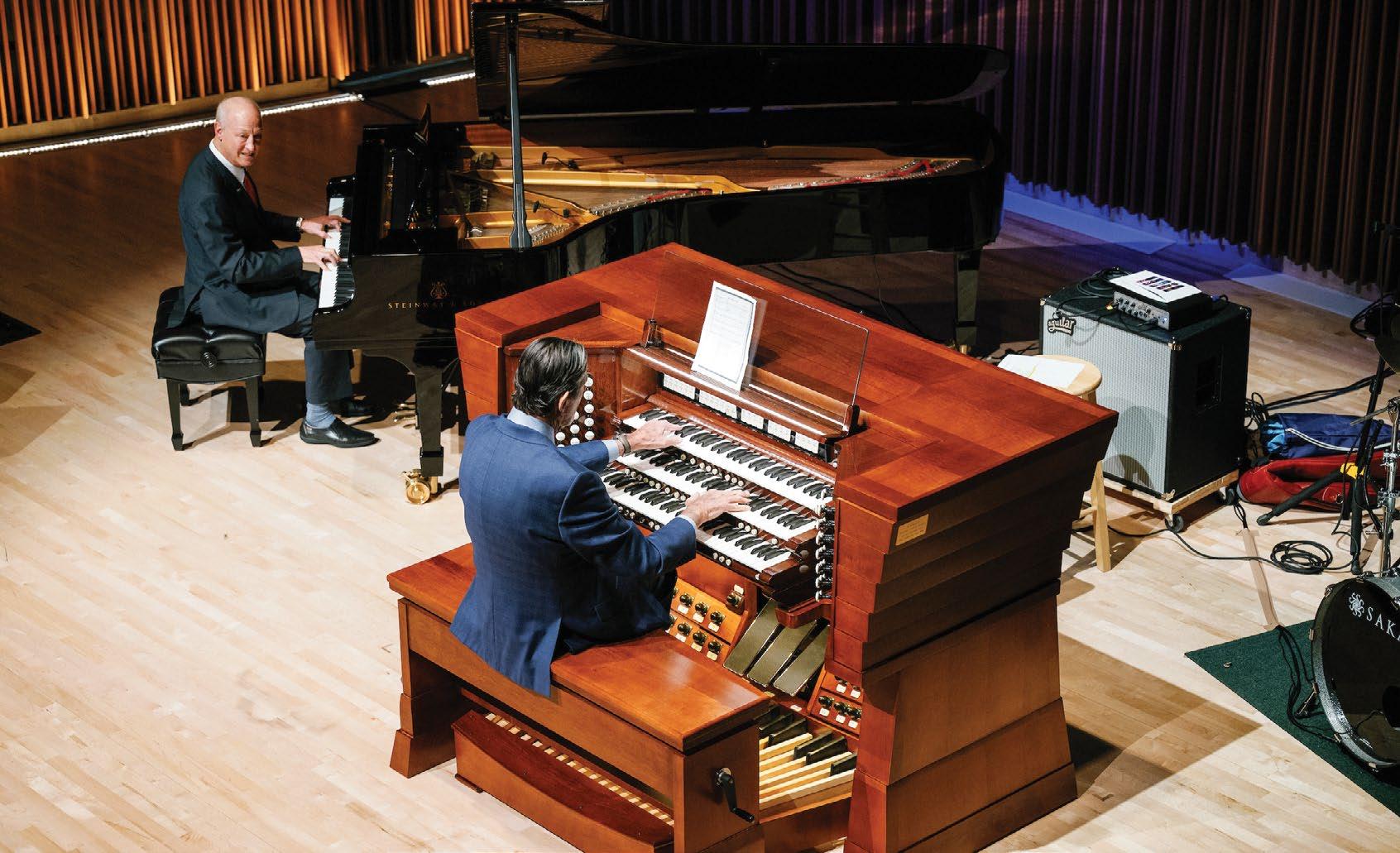

Newman, the glass is flat because the surface opposite the glass is the audience, which is absorptive. In Hormel, the surface opposite the glass is another vertical wall—there is no raised audience floor [like in Newman]. You don’t have the raised audience situation, and there’s no absorption, so I tilted the glass [to reflect sound] up into the reverberant sound field so as not to create a flutter echo.”
While both performance spaces are equipped with the latest state-of-the-art cameras, microphones, lighting, and racks of outboard gear, the real technological star of the Knight Center for Music Innovation is invisible.
“The most important thing in that space is the thing you can’t see, which is the infrastructure,” Sanchez notes. “The whole space runs on a Dante network, which is extremely flexible. What we didn’t want was the old school of running copper wires everywhere. Dante is perfect because we can put stage boxes wherever we want. We can put speakers wherever we want. All it takes is running a Cat-6 cable, just one basic networking cable, which is light, easy, cheap.”
“We have a really robust and future-proof infrastructure,” Salminen adds. “All of our switches are 10-gig switches. We have lots of data that can go basically anywhere in the entire building. What that allows us to do is, if we want to send the video image from one hall to a different hall, no problem.”
In November 2023, the Knight Center opened with a week-long series of events and concerts featuring musical performances from the Frost School of Music’s illustrious alumni and faculty showcasing the multimillion-dollar facility’s spectacular acoustics and futuristic multimedia capabilities.
“We had our wonderful opening gala,” Salminen recalls. “We had a concert with our alumni superstars, which included people like Jon Secada and Gloria Estefan, and other large jazz and contemporary acts. At one point, we had 22 musicians on stage, almost like a small pop orchestra playing, and even with minimal amplification, everything sounded great!
“From day one, our team had to plan how to achieve Dean Berg’s dreams and goals of making this an innovative and incredible space, but also make it simple and user-friendly enough that a 20-year-old kid can operate the technology,” he continues. “Can they operate it? Can they

troubleshoot it? It’s not just a performing center. This is a school, and we want the students to learn and have real-life experience.
“What I think is really unique and wonderful is that we have a small group of extensively trained student engineers who help us actually do the events. There’s no physical way for us to handle the number of events that we do. We get them up to a professional level, where they’re putting out content on a daily basis that I think rivals all the professional halls out there. This small army of extensively trained student engineers is kind of the hidden side of all this new tech and these wonderful new spaces!”
On one side of the Knight Center—the Hormel Stage side—is a two-story-high glass wall, dubbed the Windowcast, that faces a student plaza surrounded by speakers. The large panes of glass can switch from clear to opaque, and then the performances can be shared with the campus passersby.
“The first night that we did it, there was a great moment,” Sanchez recalls. “A little kid, two or three years old, walks up to the window that we are casting the orchestra onto. The
Unlock the true potential of your recordings with Primacoustic Room Kits, delivering unparalleled sound clarity and accuracy so you can hear every detail of your mix.
Scan the code to get an instant recommendation for your room.
Learn more at Primacoustic.com

orchestra is happening over in Gusman Hall, and there are multiple cameras. You see the conductor up there conducting. And this little kid—while the orchestra’s playing and the conductor’s conducting—he walks up to the window and starts conducting. That was just an awesome moment! That’s precisely what we set out to accomplish with this Windowcast—this engagement of people like that little kid who otherwise would have never been in the concert.

The idea is to bring the inside out.”
Says Todd, in summary, “To me, what’s really exciting is to see what will happen in the future, what the creative minds at the school—both the professors and the students—will do with the rooms. I look at the whole building like a canvas that will allow them to paint on it, both with natural orchestral acoustics and also with the integration of video and all the emerging new technologies.”
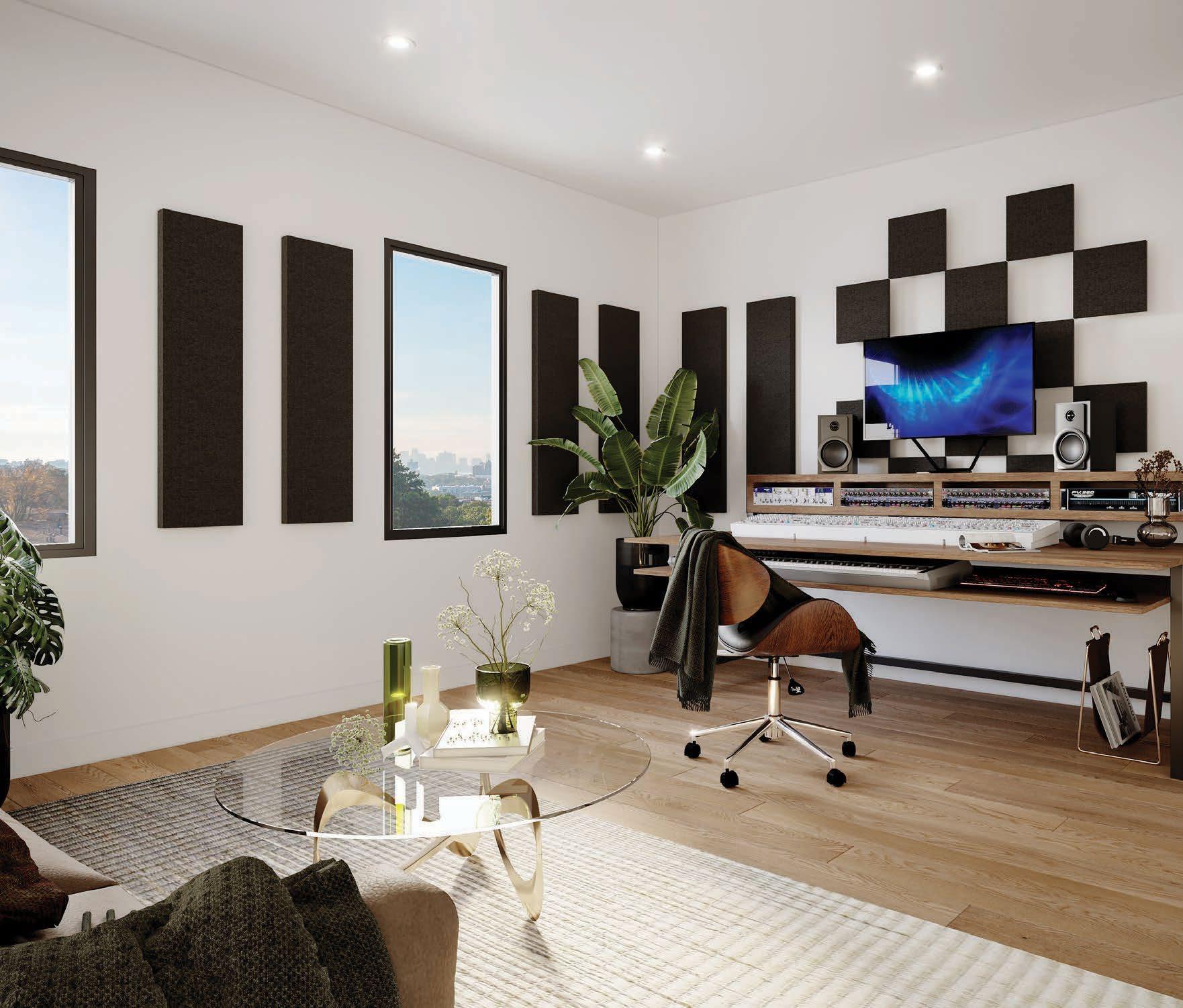

The JH Audio Pearl + Ruby IEM system is a premium in-ear monitor setup unique among currently available IEMs. Unlike traditional in-ear monitors, Ruby earpieces have only a passive low-pass filter internally; all other crossover functions are handled via DSP built into the companion Pearl Processor, a tri-amp beltpack constructed by Pearl to JH Audio specifications.
As a result, audio quality of the Ruby earpieces is reliant upon the Processor. The Ruby headphone cable is terminated with a locking, 10-pin ODU connector that mates with the Processor, so the earpieces cannot be used with conventional 3.5 mm audio outputs, nor can the Processor be used with other IEMs. It’s a system.
The Pearl Processor is described as a “micro speaker management system designed for IEMs,” employing DSP at 96 kHz (future firmware updates will enhance this to 192 kHz). It utilizes an actively controlled passive crossover, which—according to the company—can reduce latency to levels between .60 and .80 milliseconds. When combined with the latency of a typical digital console (around 1.5 mS), and an IEM system (1 mS), total IEM system latency using the Pearl + Ruby is still under 5 mS, which is critical in live performance applications. The Processor’s DSP does this by fine-tuning the crossover parameters, EQ and time alignment between Ruby drivers without use of an active low-pass filter, which would otherwise increase latency beyond acceptable levels.
The Processor is controlled by the use of three applications: Pearl GUI, Pearl Loader and Pearl Updater. GUI enables users to control gain, phase, time alignment, equalization of low, mid, and high frequencies, and levels for low-, mid- and high-frequency drivers of the Ruby earpieces. This itself is a game-changer because independent adjustments for the left and right earpieces allow compensation at the component level for differences in hearing between a listener’s left and right ears, with much more precision and repeatability than simply EQing the bus output from a mixing console (more on this later).
These settings can be saved and loaded into the Processor using Pearl Loader. A library of preset “signatures” are available

for auditioning and uploading to the Processor. Some of the presets, such as “Ruby Auratone” or “Ruby Focal Twin6 B,” mimic the sonic signature of popular monitors, while others provide subbass enhancement or flat response curves that may be used as a jump-off point for creating your own presets. The Processor holds one preset at a time, so Loader is required when you want to change presets. Updater is used only for loading firmware updates to the Processor. [Editor’s note: As of this writing, the applications run only under Windows; JH Audio is working on software for Mac that should be available this summer.]
Our Pearl + Ruby system shipped in two boxes. One contained the earpieces and cleaning tool, while the other contained the Processor; a USB thumb drive holding the software, a library of signature files, and a manual on PDF; a short USB Type A to Type C cable; and a 3.5mm-to-3.5mm jumper cable, which is required to patch audio from the output of an IEM system into the Processor. The manual supplied was version 1.0 and left a lot to be desired; a revision should be available by the time you read this.
I used the system with both generic-fit and custom, molded earpieces, and while I found that the generic versions fit my ears better than most generic earpieces, I used the custom molds for the majority of the evaluation.
The first Processor I received was a bit temperamental. I had trouble getting it to connect consistently to the GUI (albeit running Windows on a Mac under Boot Camp), and at one point, it locked up. I did not care for the implementation of the power button, which was difficult to press. This was replaced with a second Pearl Processor, which has been playing happily with my Mac for weeks and has a power button that’s easier to use.
The Processor is a solid little unit at approximately 3 x 2.5 x .75 inches. At the top of the pack are a 3.5mm audio input jack, a threecolor input-level LED and an ODU jack for the Ruby headphone cable. The side panel features a status LED, USB Type C port for
charging and programming the Processor, and the power switch. A belt clip can be found on the rear panel. There is no user access to the rechargeable battery, which runs up to 10 hours on a full charge. Construction of the pack is very well done. It feels solid and the finish speaks to its pedigree, though, depending upon the viewing angle, I did find it difficult at times to discern whether the status LED was yellow or green.
Opening the GUI displays a main screen with individual left and right faders for Input, Low, Mid and High bands, with phase, mute and gain for each. Tabs at the top of the screen provide access to the Low, Mid, and High bands, while controls at the top right allow you to sync the software with the pack, save the file as a preset, or load a preset signature file. When the Processor is synced to the GUI, the Status window shows “Connected” in green, and the faders will snap to the values saved in the preset.
Prior to diving in, I simply used Loader to audition the supplied preset files. Changing from preset to preset, I could clearly hear the different audio signatures, and while some may tickle your tastebuds, all of them show off the audio quality of the Rubys. Processor notwithstanding, the Rubys sound fantastic. The midrange (vocals in particular) is smooth as silk, high end is clear and extended, and bottom end (depending upon the preset loaded) can almost fool you into believing there’s a subwoofer hidden somewhere nearby.
It’s also apparent that amplification in the Processor is first-rate. When driven to levels louder than I’d care to monitor, the system never sounds like it’s running out of gas (though the Processor adds some background hiss). As such, the Rubys can definitely serve as reference monitors in a mixing application.
The Low, Mid and High screens are where you can adjust EQ, filters, delay and levels for each band. Controls for Low include two bands of parametric or shelf EQ, high-pass and lowpass filters, and delay. Mid offers four bands of parametric, EQ, high-pass and low-pass filters, and delay. High provides six bands of parametric EQ, plus high-pass filter and delay. EQ and delay can be ganged, but the faders cannot. Initially, I found this amount of control a bit intimidating, but keep in mind that if you dive down the rabbit hole, you can always come back to the preset library to bail you out.

I started with a preset called Ruby Live Flat Bass .86 Latency, tweaked the Low faders up a few dB and headed for the rehearsal room. Patching my electronic drums into the Ruby was an ear-opener— especially in the bottom end, which was full and solid. It’s possible to adjust the delay of each band (up to 10 mS) with accuracy within a fraction of a microsecond, which changes the phase response of the Ruby as well as one’s spatial perception of the audio. Delay values are entered in milliseconds, so typing “1” results in a delay of 1 mS. Setting the delay under 1 mS requires typing “0.X,” and you can’t click in the field and drag to change the delay time. I nearly always deferred to the settings provided with the presets.
While the amount of control over the EQ and phase response of the Rubys may sound like a novelty, there’s something far more important to consider: The ability to alter the response of the earpieces can be used as a means of “leveling the playing field” between a monitor engineer and performer.
Jerry Harvey himself was kind (and patient) enough to relate to me his recent experience of being dragged out of retirement as a monitor engineer to hit the road with an international artist. Audiograms (essentially the frequency response of a person’s ears) were made for each performer on the tour, as well as for the monitor engineers. Knowing the hearing characteristics of a particular performer enables an ME to understand
COMPANY: JH Audio
PRODUCT: Pearl Processor + Ruby IEMs
WEBSITE: jhaudio.com
PRICE: $3,500.00 (generic fit); $3,700.00 (custom molds)
PROS: Very high-quality sound; preset “signatures” enable a monitor engineer to more accurately hear what a performer hears; extremely low-latency processing
CONS: Amplifier pack adds background noise; software is Windows-only; pack doesn’t show charging status unless powered on; documentation leaves something to be desired
and compensate for the performer’s hearing losses. That’s not to say that if, for example, a guitar player has a 6 dB notch in their hearing at 2 kHz, one can simply fix it by using the GUI to create a preset with a reciprocal curve—it’s a far more subtle process than that. But at the very least, it gives the ME a better understanding of what a performer is hearing and why.
Furthermore, given an audiogram of the monitor engineer, it’s possible to create presets for each performer that reconcile the differences in hearing between the ME and the respective performers—and that’s a game-changer. JH Audio is also working on presets that mimic other IEMs, which means that a performer can use the IEMs of their choice, while a monitor engineer uses a Pearl + Ruby system running a preset that simulates the behavior of the performer’s in-ears, making it easier for the ME to understand and address the performer’s IEM mix.
Looking at the Pearl + Ruby from a global view, I see three distinct applications: They can be used as a portable high-end monitoring platform that translates to a variety of popular studio monitors; they can be tailored to a listener’s taste regardless of their hearing profile, and they can promote consistency in a monitoring system between performers and their monitor engineer(s). That’s an awful lot of power to wield, and it requires that users have a thorough understanding of how to apply compensating curves to “fix” a listener’s hearing experience.
The price of the Pearl + Ruby system is not exorbitant, but right now it’s probably out of reach for all but A-level tours—and the fidelity is certainly worth the entry fee. Hopefully the technology will trickle down to more affordable price points in the future so that a wider audience can reap the benefits. Kudos to JH Audio for pushing the limits of IEM technology. n
When I hear “convolution,” I immediately think “reverb,” or “speaker cabinet.” Of course, convolution in pro audio—the process of applying a previously captured impulse response to another audio signal, such as on an instrument or vocal track—isn’t theoretically limited to using only ’verb and cab IRs.
Heavyocity’s new stereo plug-in Vast lets you use any audio file you wish as an IR, as long as it’s under 60 seconds in duration. (Birdsong-modified grand piano, anyone?) And while the plug-in also provides convolution reverbs, it does so with panache, dishing out reverse and tempo-synced ’verbs offered by few competing products. Other IRs in the plug-in’s library (202 at press time) apply rhythmic grooves to your tracks, fundamentally changing their performance in surprising ways.
The factory-supplied IRs are organized (in a separate browser) in eight categories—Rooms, Halls, Plates, Springs, Large, Immense, Rhythmic and Textures—the first six of which are conventional reverbs. Vast also includes 239 global presets, each of which loads an IR in combination with factory-supplied effects specifically tailored for it. Remember this before loading a new preset to use its groovy effects chain, as doing so will also switch to a new IR.
The seven user-adjustable effect modules include EQ, Gate, Compressor, Delay, Convolution, Dry/Wet Mix and Output. Clicking on a module opens its control set at the bottom of the UI. With the exception of the Output module, you can change the order in which a module is placed in the plugin’s series-connected audio path by simply clicking on it and dragging left or right. Each module can also be bypassed or soloed.
Most of the modules also have a slider below them that you can drag to change its associated effect’s wet/dry mix or intensity (for example, the gate’s ratio). The Output module is again the exception, substituting instead a useful switch for turning an additional reverb on and off. After you’ve tweaked the modules’ parameters to your
liking, you can load different IRs in turn—auditioning larger or smaller reverb sizes, for example—without affecting the UI’s control settings.
Of all the effect modules, Convolution is the star attraction. This is your gateway to loading factory-supplied IRs or your own files. To load your own, simply drag and drop a .wav or .aiff file onto the waveform display, which sits above the effect modules in the UI. Alternatively, you can load a factory IR by double-clicking it in Vast’s dedicated IR browser. Mark your favorite IRs for fast retrieval, and expedite your browser surfing by filtering the library’s offerings by category of IR (e.g., Rooms or Rhythmic). Keep in mind that importing your own audio file for use as an IR does not make a copy of it; it’s a good idea to create a folder on your storage drive for all your custom IRs so that you can quickly find them and drag them into a Vast preset.
The waveform display can be switched between an amplitudebased framework, like how your audio tracks are displayed in your DAW, and a frequency-based spectrograph—except when you select the EQ module, where the display shows an interactive

frequency-response graph of your filter adjustments. The display section’s ultimate power lies in complementary controls that let you quickly adjust the currently loaded IR’s start and end points, and reverse its impulse response. That last trick is how VAST creates reverse reverbs.
You are able to transform the currently loaded IR even further within the Convolution module, where 13 controls let you sync the length of the IR to your DAW’s tempo, set a pre-delay time before the convolution signal starts, adjust the IR’s pitch and resonance, add modulation and/or diffusion to the IR, apply fade-in and/or fade-out to the file, and adjust its stereo image independently in its low- and high-frequency ranges. Unfortunately, dedicated IR presets are not supported, so you can’t save your tweaks to an IR (in the waveform display and Convolution control set) separately from the global preset it’s being used in. The predelay slider also lacks a readout when making manual adjustments not synced to your DAW, an imprecise proposition.

degrade the delay’s audio quality (selecting either an “analog” or “digital” flavor), modulate the delay (by adjusting controls for modulation rate and intensity), apply feedback to increase the number of echoes produced, and shift the pitch of the delayed signal. Clicking a toggle places the pitch shifter after the delay’s feedback circuit to make each successive echo rise or fall in pitch, depending on the rotary Pitch control’s setting. Like the Convolution and Compressor modules, the Delay module has its own wet/dry Mix control.
The EQ module provides three bands outfitted with parametric bell-curve equalization and two other bands that offer various combinations of shelving, high-pass and low-pass filters. A helpful Amount slider scales the equalizer’s overall effect.
Vast’s Gate and Compressor modules offer more than just the usual threshold, ratio, attack and release controls, plus makeup-gain and wet/ dry-mix controls for the compressor. You can independently adjust the cutoff frequencies for high-pass and low-pass filters in each module’s sidechain. Alternatively, an internal LFO— with adjustable rate and width controls—can modulate the Gate’s detector signal.
High-pass and low-pass filters also populate the Delay module. You can set the module’s delay time manually or sync it to your DAW’s tempo, create ping-pong echoes by applying a delay-time offset between left and right channels,
Vast’s Output module includes three (independently bypassable) signal processors— reverb, EQ and a clipper—that are applied in series after all the other modules. Seven different reverbs are singly offered, with separate controls to adjust their brightness and wet/dry balance. The EQ, called “Tone” in this module, alternately
COMPANY: Heavyocity
PRODUCT: Vast
WEBSITE: Heavyocity.com
PRICE: $99 retail; $79 crossgrade
PROS: High-quality convolution reverbs and unusual IRs enhance or radically transform tracks. Custom .wav and .aiff files can be imported for use as IRs. IRs can be processed in many ways.
CONS: IR tweaks can’t be saved as presets separate from global presets. Presets can’t be marked as favorites. Creating unusual sounds for practical use can be hit-and-miss.
serves up either low- and highshelving filters (with adjustable gain) or high-pass and lowpass filters (with adjustable corner frequencies). Control any one of six different types of clippers using their shared Threshold control.
With a little browsing, I could always find a conventional room, plate or chamber reverb that sounded great on vocals, trap drums and electric guitar tracks, but where Vast really shines is in its offering of absolutely humongous Immense-category reverbs, which are bound to find a home on spacey Enyainspired ballads and in cinematic sci-fi FX tracks. Sound editors working in horror and sci-fi will also find very fertile (and warped) ground in IRs from the Rhythmic and Textures categories. The Rhythmic category of IRs also yielded interesting results on snare drum tracks, sometimes radically changing the groove. The only downside (or not!) is that the result often sounded a bit phase-y.
The Textures IRs evoke Forrest Gump’s proverbial box of chocolates—you never know what you’re gonna get. With Vast’s output set to 100% wet—and my dry track’s faders all the way down and its insert sends set to pre-fader—a monophonic electric guitar vamp became an eerily whistling banshee with one Textures IR applied and an electrified harmonium with another. An IR can also sound quite different depending on the audio source feeding it. You can get some truly unusual sounds, but it might take some hit-and-miss fiddling to make them usable.
In fact, some of Vast’s global presets are so unusual and engaging, I wish I could mark them as favorites (as you can with IRs) and write in a comments field what applications or productions I like using them for.
Whether you want a high-quality convolution reverb or a very flexible tool to utterly transform your sample libraries, Vast is a strong contender for both music production and sound design. Vast’s ability to heavily modify the groove of music tracks is also a distinctive feature, breaking alien ground not ventured onto by other convolution plug-ins that I’m aware of. I like that! n
Harrison Audio recently released three 500 Series processors: the 32Cpre+ preamp, MR3eq three-band equalizer, and Comp, a VCA compressor. All feature technology from the company’s large-format consoles of the ’70s, ’80s and ’90s. The single-slot, mono processors represent the company’s first foray into the 500 Series market.
The 32Cpre+ gets its name from Harrison’s 32Classic console, whose preamps feature similar transformer-coupled technology. The 32Cpre+ is equipped with the same Jensen JT-MB-CPCA transformer used on the console channels, providing low noise and excellent frequency response.
One of the 32Cpre+’s handiest features is a front-panel combo jack that supports mic- and instrument-level sources. Pressing the Hi-Z or XLR button just above the jack activates the combo input and deactivates the back-panel XLR. This arrangement lets you have a default mic connection through the back output but keeps your options open to connect a mic or DI source through the front panel.
One minor issue on my review unit was that the 1/4-inch jack felt “sticky” when unplugging cables. The connector worked fine, but pulling a jack out required more strength than it should. I didn’t have the same issue with XLR cables, which connected and disconnected smoothly and efficiently. I’m guessing that the 1/4-inch tightness was anomalous to my review unit, but not having another to compare it with, I can’t say for sure.
The preamp’s 20 dB to 70 dB gain range is controlled with the conveniently large and redcolored Micpre Gain knob. Three switches to the left activate polarity reverse, 48V phantom power and a -20 dB pad.
Pressing the “In” button at the top turns on the filter section. The High- and Low-Pass Filters have a 12 dB/octave slope and a wide range for setting the corner frequency. The former goes from 25 Hz to 3.1 kHz, and the latter from 160 Hz to 20 kHz. Those ranges are large for a 500 Series preamp
(many only offer a fixed-frequency high-pass filter and no low-pass filter) and are likely more expansive than you’ll ever need. Still, it’s better to have too many choices than too few.
The metering is simple: An input LED turns green to show signal activity, deep red for clipping, and lighter red when hot but not fully clipped. In a perfect world, I’d prefer a meter with more detail, as it makes level-setting easier and more precise. However, because of the relatively small size of 500 Series processors, manufacturers often have to compromise design to get everything to fit.
With a price of $699 for one channel, which falls in the middle of the range for 500 Series preamps, I expected quality tone from the 32Cpre+, and it did not disappoint.

I used it when miking vocals, acoustic guitar, mandolin, DI bass and DI electric guitar. The resultant recordings were not only clean and detailed but also had a subtle roundness that yielded a pleasing, natural sound that was free from harshness. I did an A/B comparison with other preamps in my studio, and it held up favorably to them all.
From a control standpoint, the MR3eq is similar to the channel EQs on the 32Classic console. Both feature low and high bands, each with a 6 dB/octave shelving filter, a knob for boosting or cutting by 10 dB, and a button that switches from a shelf to a bell filter.
The low and high bands don’t have useradjustable Q controls, but their bell filters feature proportional-Q circuits, which cause the bandwidth to increase or decrease based on the amount of boost or cut. The choice of shelving or bell filters for those bands makes the EQ more versatile.
The mid-band is not the same as on the 32 Classic’s channel EQ, which has two semi-parametric midbands. The MR3eq features one fully parametric mid-band with controls for Corner Frequency, Boost/Cut and Q. The frequency ranges of the three bands overlap significantly, which provides additional flexibility.
The unit also has a switchable High-Pass Filter with a wide corner frequency range of 25 Hz to 3.15 kHz, as on the 32Cpre+. If you’re using the MR3eq in conjunction with the 32Cpre+, you won’t need the filter, but with the EQ on its own, the HPF is handy.
In addition, the EQ and filter sections have an In button that allows you to switch them in or out of the circuit. These are useful, especially for comparing the sound with and without processing. However, there are no status LEDs to indicate when either of those sections is active, so you have to figure that out based on whether the In button appears to be pressed.
Overall, I liked the MR3eq a whole lot. For recording vocals and instruments or as a hardware insert when mixing, it always helped to improve the sound. On a strummed acoustic guitar, for example, I used it to beef up the lower-mids while adding extra sparkle on top. Another time, with a DI Fender Precision bass, I boosted slightly at around 130 Hz for added bottom and at about 1 kHz for a more distinct top end.
The controls on any analog EQ aren’t as precise as on a digital equivalent, so you end up using your ears more and your eyes less as you’re dialing in a setting. That’s a good thing, in my estimation. The sound quality, design and workflow of the MR3eq offer similar design, sound and feel to what you’d find on the channel EQ of a large-format analog console, which I presume is what Harrison was going for.
COMPANY: Harrison Audio
PRODUCT: 32Cpre+, MR3eq and Comp
WEBSITE: harrisonaudio.com
PRICE: 32Cpre+ ($699), MR3eq ($399), Comp ($399)
PROS: All three processors use analog technology from Harrison consoles and offer excellent sound quality. 32Cpre+’s front-panel combo jack provides connection flexibility in conjunction with the back-panel jack on the 500 Series frame. The High and Low-Pass Filters on the 32Cpre+ and the Low-Pass Filter on the MR3eq offer extremely wide frequency ranges. Program Dependent Attack on Comp is quite effective.
CONS: 1/4-inch part of front panel combo jack on review unit was stiff. Metering lacks detail. Hard to tell the status of the buttons on the MR3eq. No adjustable attack on Comp.
Harrison’s compressor technology was first developed for the company’s broadcast consoles. Dave Harrison, who founded the company in 1975, initially was not a fan of compressors for music, but he relented and included them on his broadcast consoles because of that industry’s need to control levels and prevent clipping. As a result, Harrison compressors were designed first and foremost for leveling purposes.
The compressor in Comp follows a similar design, featuring a THAT 2180 VCA chip and a feed-forward architecture. For those unfamiliar, a feed-forward VCA compressor’s detector gets its signal from the sidechain before it hits the VCA, whereas a feedback-style unit gets it afterward. As a result, feedforward units can better capture transients but aren’t typically as smooth-sounding.


The controls on Comp include an In button (on/off) as well as knobs for Threshold, Release time, Makeup gain and Ratio. Oddly, the latter’s labeling is reversed from normal; for example, 1:2 instead of 2:1. I asked Harrison about this and was told that was how they expressed ratio on the compressor that Comp is based on, so they kept it the same.
You may have noticed I didn’t mention an attack time control. That’s because there isn’t one. The attack is program-dependent—it changes based on the amplitude and frequency of the signal. Although I prefer the control of a dedicated attack knob, I have to admit that Comp’s automatic settings were usually satisfactory.
Harrison suggests setting a fast release and low ratio to use Comp as a leveler. I tried that, and it worked well for reducing peaks and keeping dynamics under control on sources like vocals, snare drum and bass.
Harrison touts Comp as a “vibe compressor,” and, indeed, it can add character with higher gain reduction amounts and slower release times. For example, I used it to soften the transients and lengthen the sustain on a snare, giving it a pumping sound. Perhaps because of the
compressor’s feed-forward design, Comp is very sensitive to transients, and I had to be careful not to squash the signal too much. I noticed that it’s not only the Threshold and Ratio controls that impact the amount of compression; so does the input level.
As with the MR3eq, I appreciated dialing in settings mainly by ear without the visual feedback and distractions of a plug-in screen. It made me realize that it’s not just the sound of an analog processor that’s appealing, it’s also the workflow. As you adjust the sound, there’s no computer between you and the music, and you feel a more direct connection to it.
My overall experience with Harrison’s new 500 Series processors was highly positive. They all provide solid performance and excellent sound quality. The MR3eq and Comp, in particular, also offer outstanding value. The 32Cpre+ is pricier but still quite reasonable for the quality it provides.
Individually, all three are notable products. Put them together in your 500 Series rack, and you’ll have a powerful and versatile console-style input chain for vocals or instruments. n
 By Craig Anderton
By Craig Anderton
In George Orwell’s novel 1984, the Two Minutes Hate was a daily ritual practiced by the citizens of Oceania.
As they watched a giant video screen projecting the Party’s enemy, they were expected to shout, curse, spit and show intense loyalty by exhibiting intense hatred for the enemy.
And speaking of online comments sections....
We’re all aware of social media’s toxic potential. Even within our generally friendly little industry, sometimes the exchanges about gear, artists and so on border on the Two Minutes Hate zone. Take the latest Taylor Swift double album. Some were thrilled to have so much music, of such a personal nature, in their collection. It broke all streaming records upon its release. Reviews have called it “ambitious,” “audacious” and “irresistible.”
Then the Two Minutes Hate kicked in. “It’s just a money grab,” “I guess she got a thesaurus for Christmas,” “sounds the same as her last album,” and (ouch) “this is an era you endure, not enjoy.”
But…they’re talking about the same album. The album doesn’t shapeshift into something horrible for some people and transcendent for others. Perhaps their comments relate less to the album than to Heisenberg’s Uncertainty Principle.
Say what? Well, simply stated, the Uncertainty Principle asserts that the more accurately we measure one property of a pair of properties, the less accurately we can measure the other property. Although Heisenberg was talking about a pair of properties like a particle’s position and momentum, it may go beyond that. In the Taylor Swift example, the haters measured what they didn’t like about the album, so any measurement of what they might like was already influenced by what they didn’t like. Conversely, those who measured what they liked about the album probably didn’t think about measuring a potential cash grab aspect.
The bottom line is that one person thought the review was negative because he felt the product had nothing to offer him. Therefore, it couldn’t possibly be any good. The person who thought the review was positive found that it provided functionality he needed, so therefore it was a good product. Both thought they had made up their minds about a product—but they hadn’t. They’d made up their minds about how they saw the product. Each person measured one of the product’s properties accurately, but not the other one.
Now, it might seem that this column’s conclusion would be “don’t do hate-filled screeds online, tolerance is good, all you need is love, blah blah blah.” But there’s a more important point.
Certainty can be slippery, so we need to remember that whatever we think could very well be wrong. At any moment, an experience could change our perspective—because it forces us to measure something we hadn’t considered. Take vinyl. I grew up with vinyl, and I didn’t like the surface noise, crackles, inner groove distortion, inevitable deterioration, constant cleaning and so on. When people who hadn’t been raised on vinyl started telling me how “warm” it sounded, and how the sound was so much better than CDs, I was dismissive. Are you kidding? By any standard of measurement, digital audio has superior fidelity. Case closed.
Music and sound quality are fine examples of a pair of physical quantities that describe a system. I was measuring the sound quality. He was measuring the music. Listening from his perspective, I understood…
So, I asked a vinyl junkie friend to play me some vinyl that he thought sounded better than a CD. He played a bunch of records from the ’60s and ’70s, and then gave me a look like, “See? It’s clearly better!”
Maybe people just have a hard time reconciling that two opposing viewpoints can both be correct. Mention Behringer, and some will opine that they’re Made in China ripped-off designs with questionable (at best) quality. Others will talk in rapturous tones about their X32 mixer and the surprisingly good performance of their inexpensive audio interfaces.
Perhaps what really shapes someone’s perspective is “what’s in it for me.” Many years ago, I reviewed Native Instruments’ Kore. One friend said, “Wow, that review was so negative. Did NI cancel their advertising?” Later, a composer thanked me for the positive review, saying that because of it, he immediately bought Kore and couldn’t have been happier. They were talking about the same review, of the same product.
Then it hit me: Heisenberg. Music and sound quality are fine examples of a pair of physical quantities that describe a system. I was measuring the sound quality. He was measuring the music. Listening from his perspective, I understood: The music had dynamic range, it wasn’t harsh, and hadn’t been remastered to unleash a “modern” too loud/too bright sonic assault. He loved the sound of the music. He didn’t need to love the sound of the vinyl. That’s not what he was measuring.
You may think Taylor Swift is doing a cash grab, but still appreciate her music. You can think Behringer makes some garbage gear, yet still be happy about taking your X32 to gigs. You might feel that Kore has nothing to offer you, but still understand NI is taking significant steps toward product integration.
Do we truly know all the perspectives needed to accurately measure and describe a system? If not, then what we know is probably wrong. And actually, that’s kinda great. Because at some point, you’ll find out what you didn’t know, revise how you think, change your perspective, and be that much the wiser for it. ■
